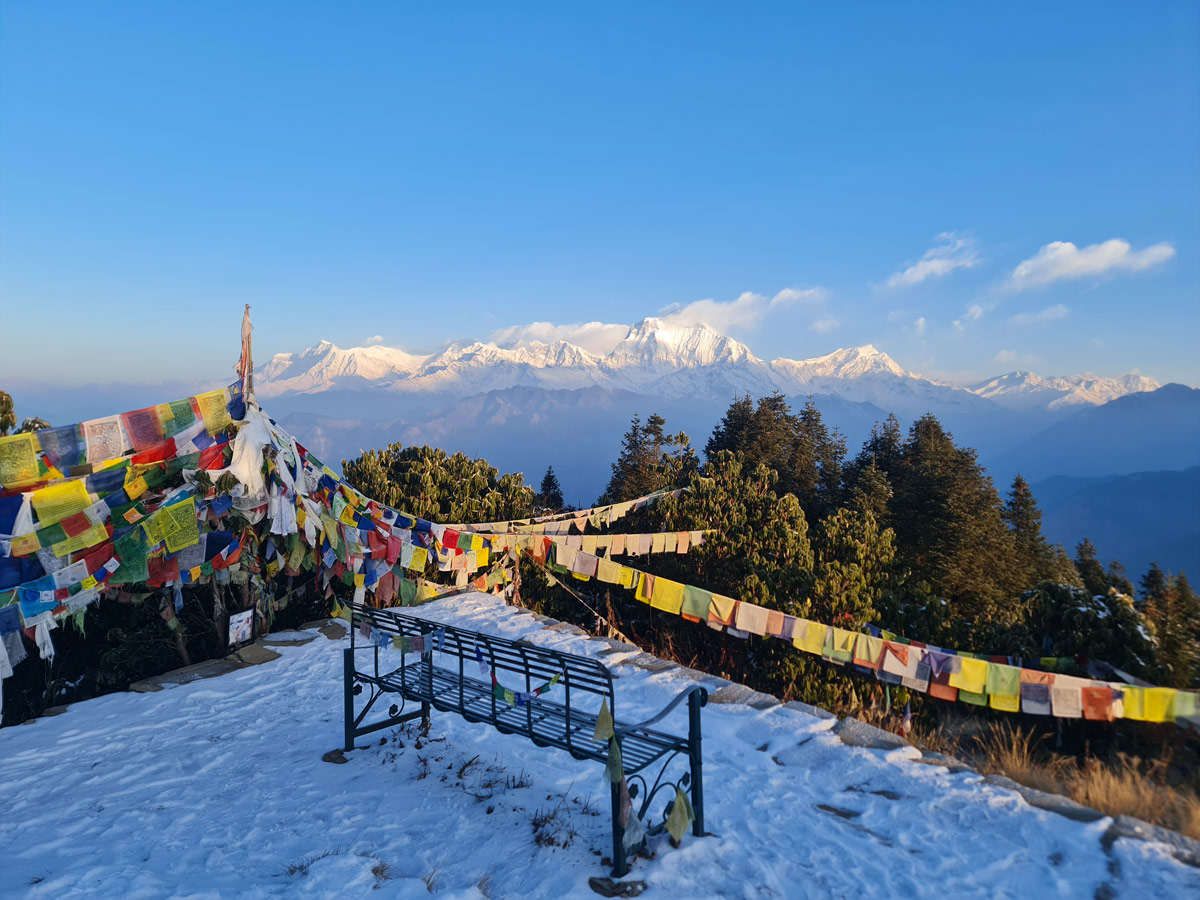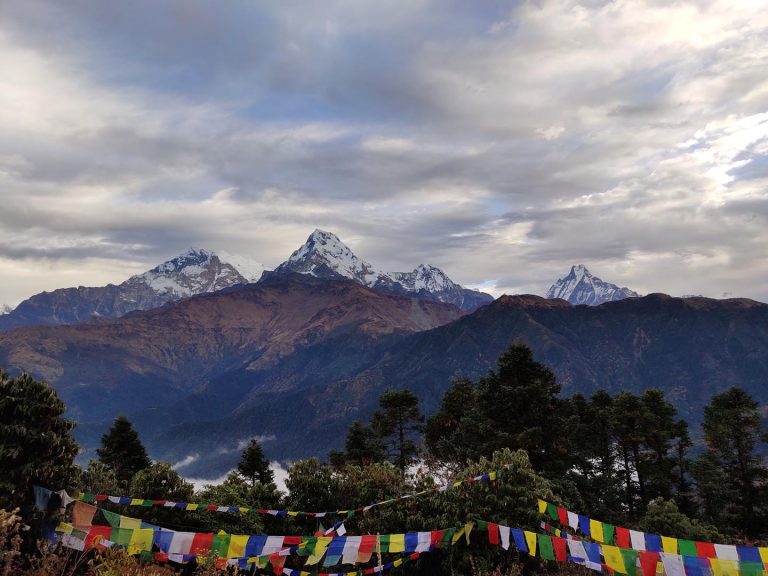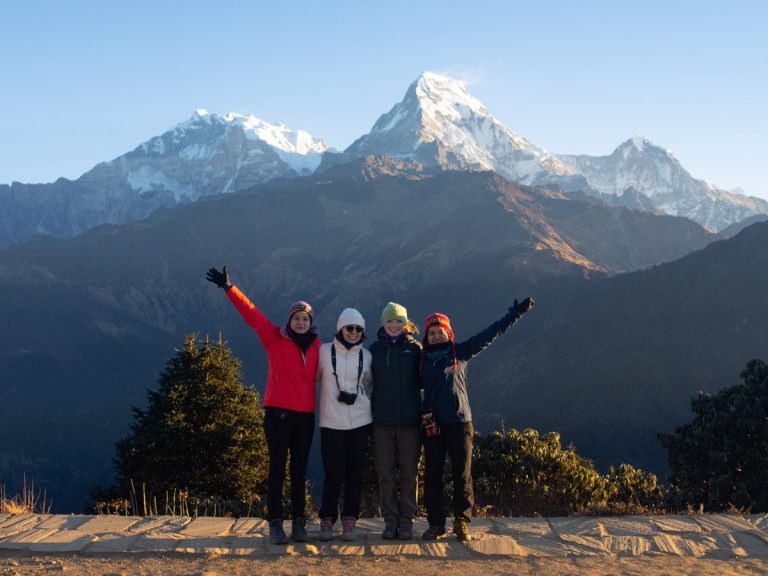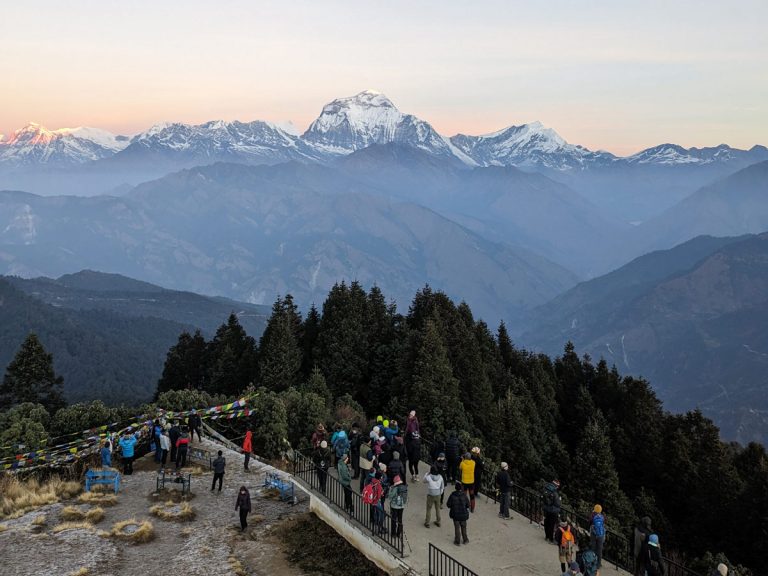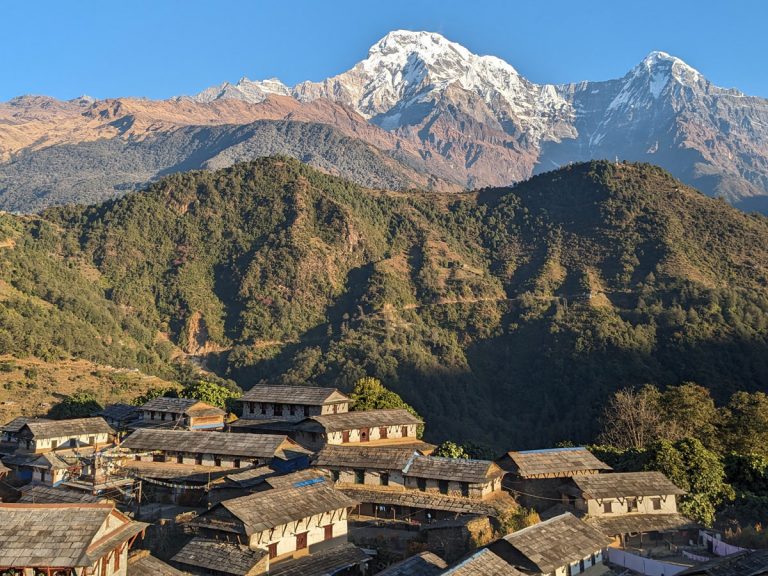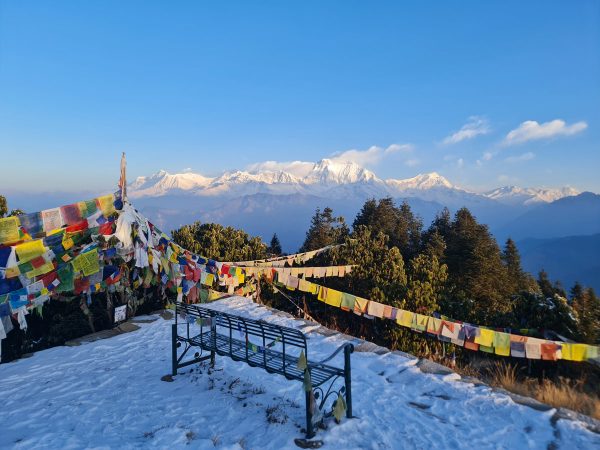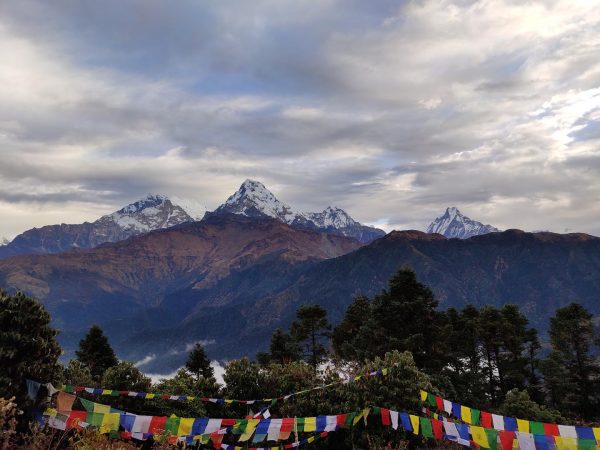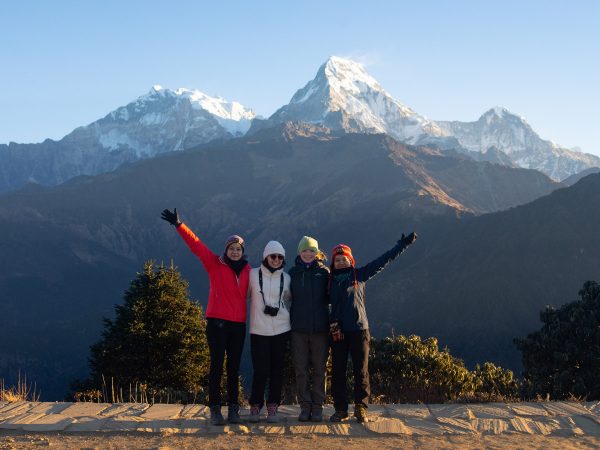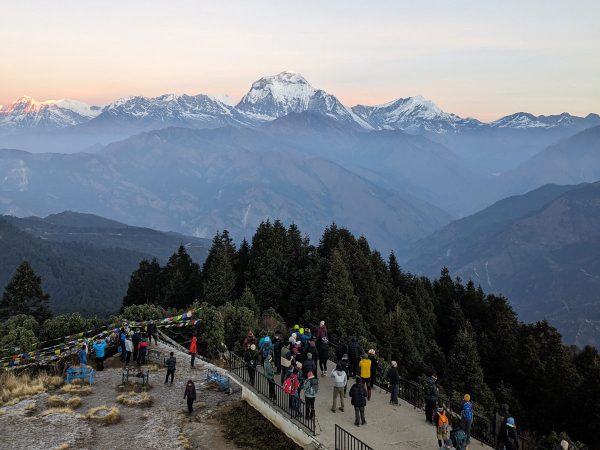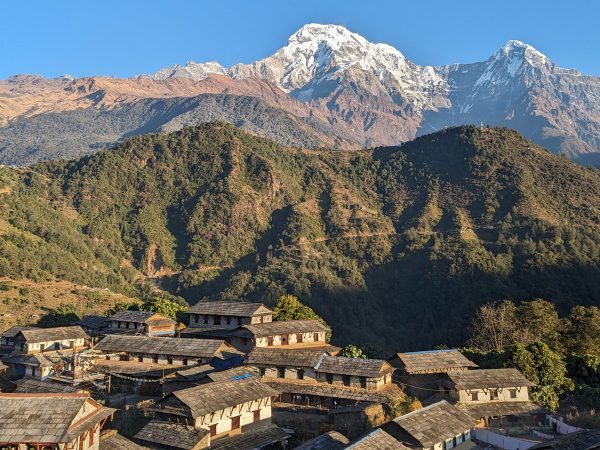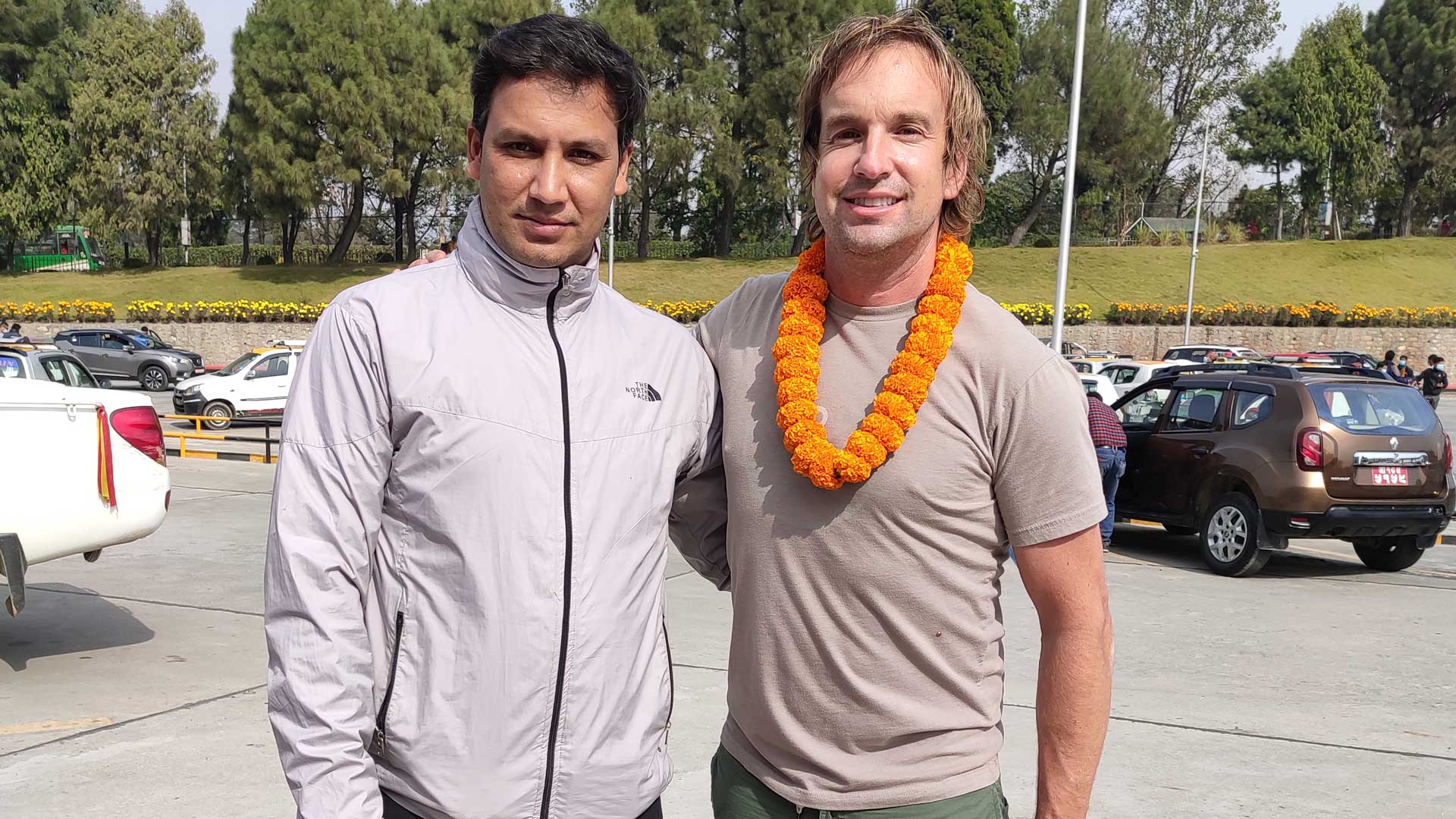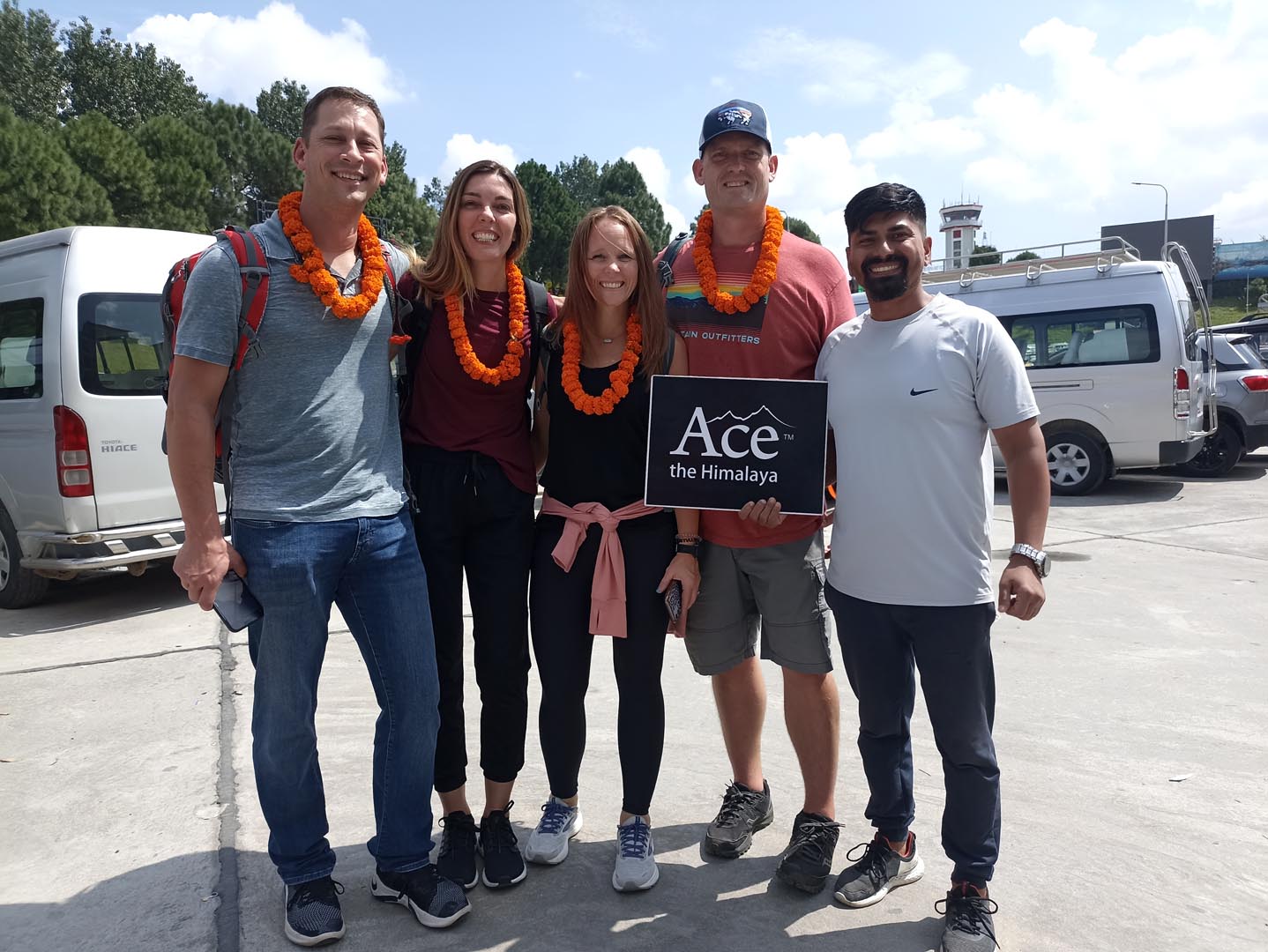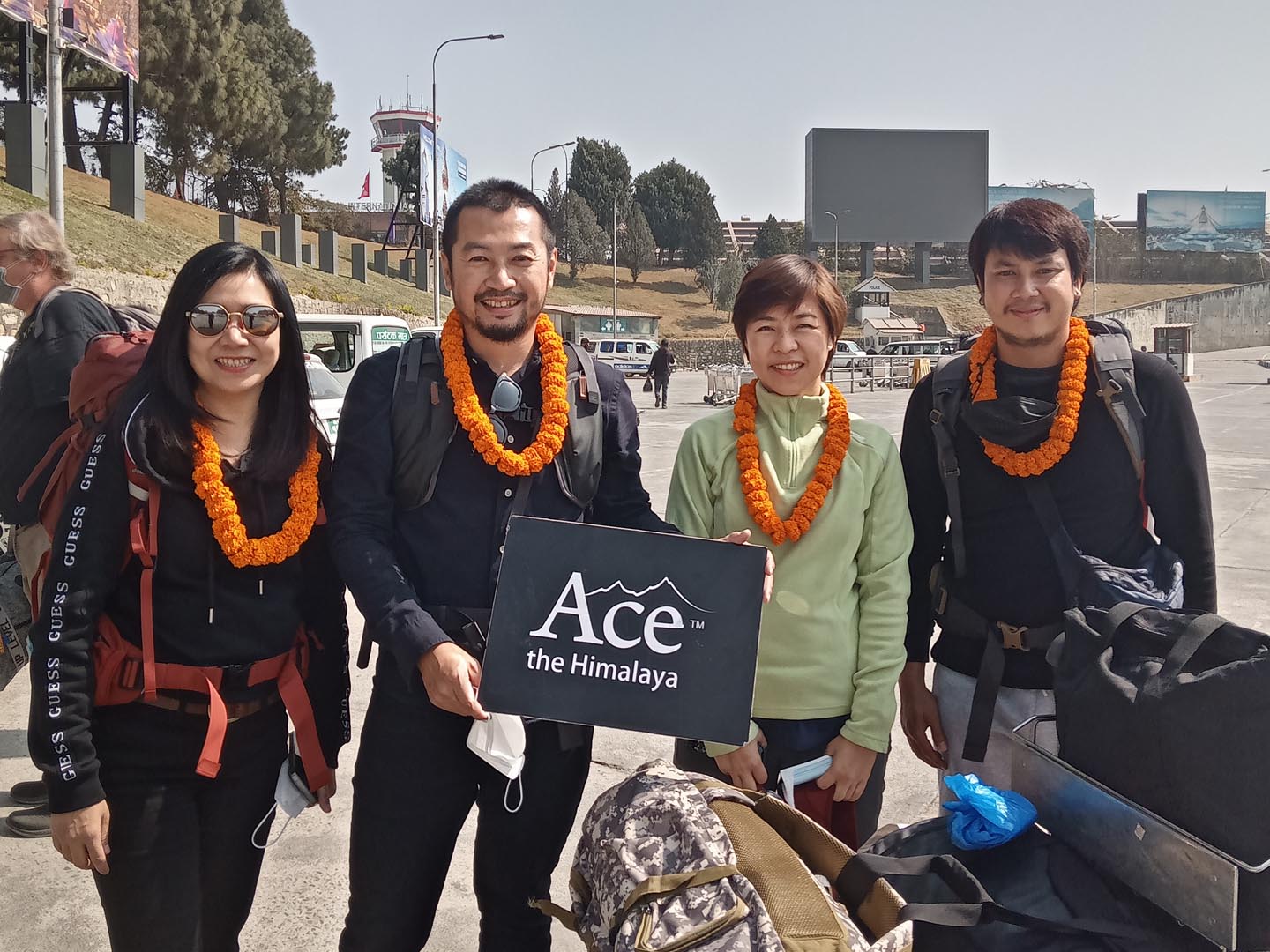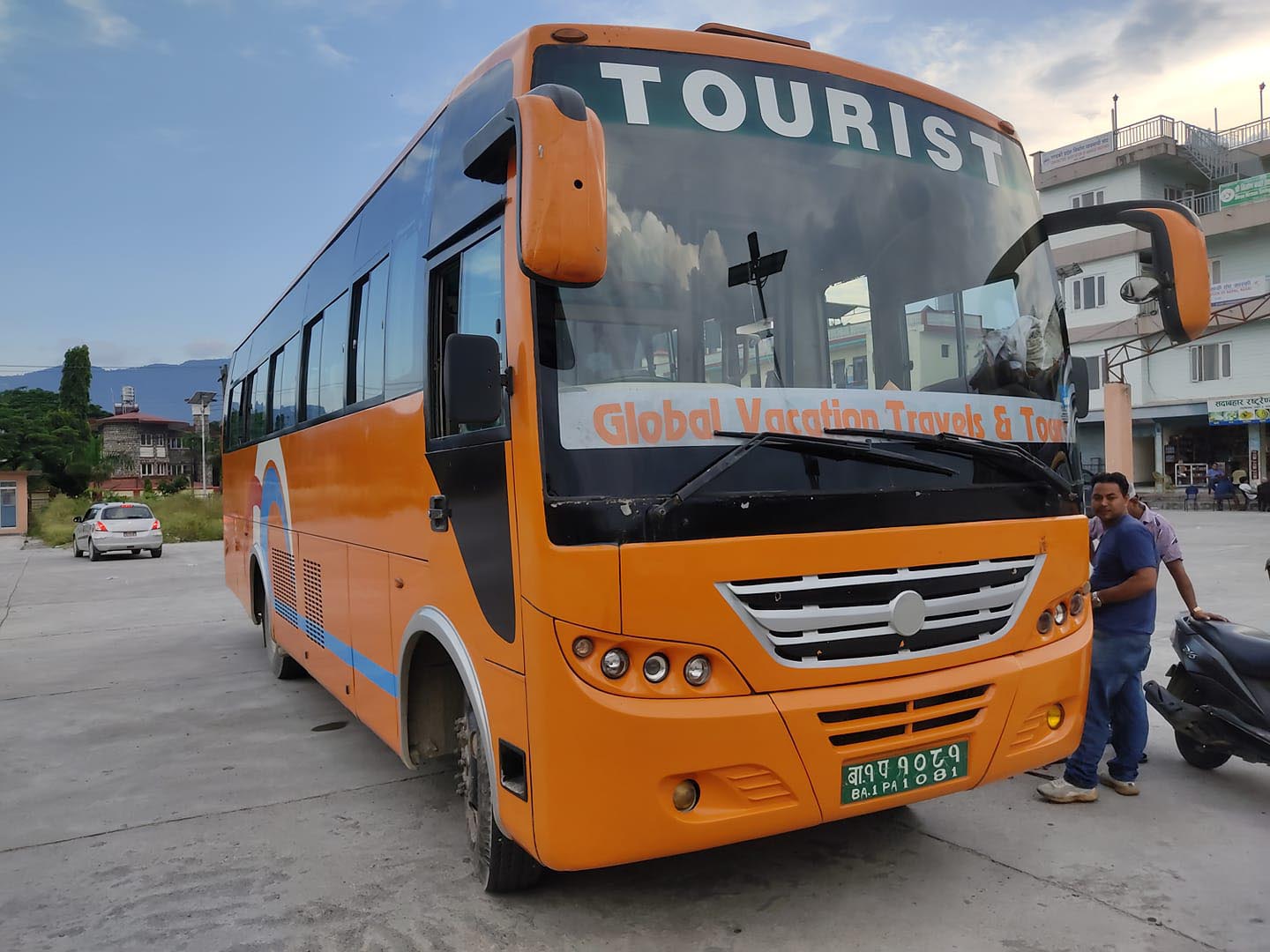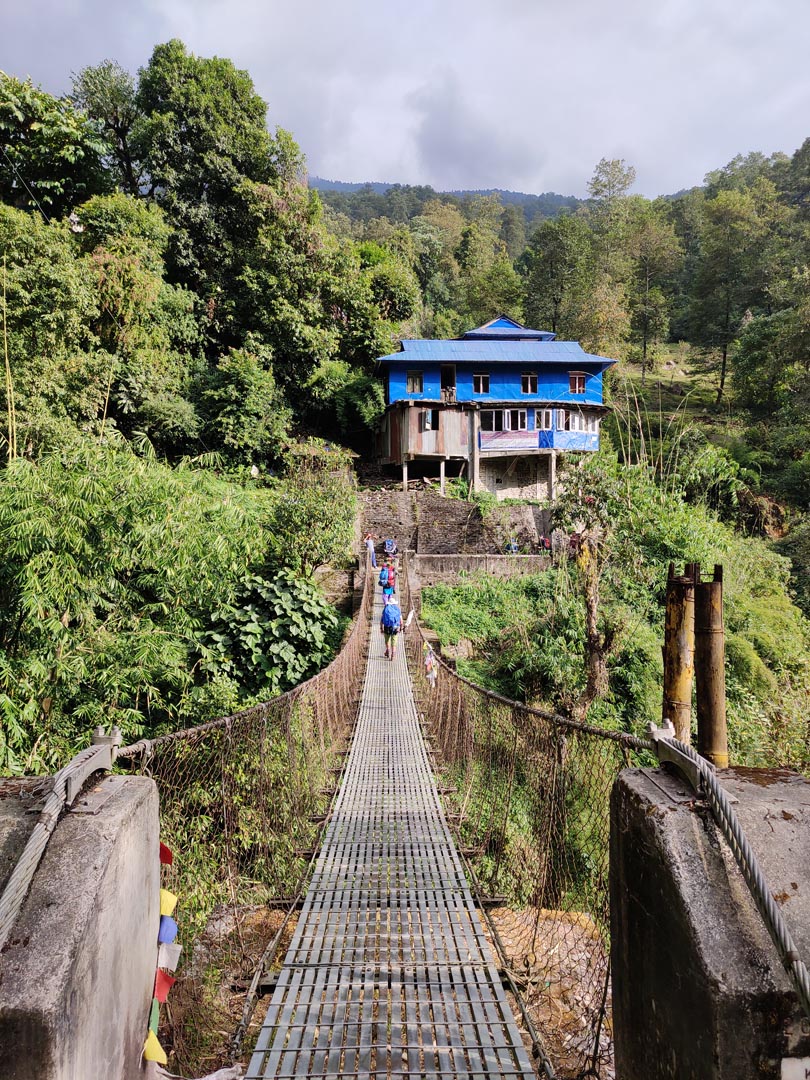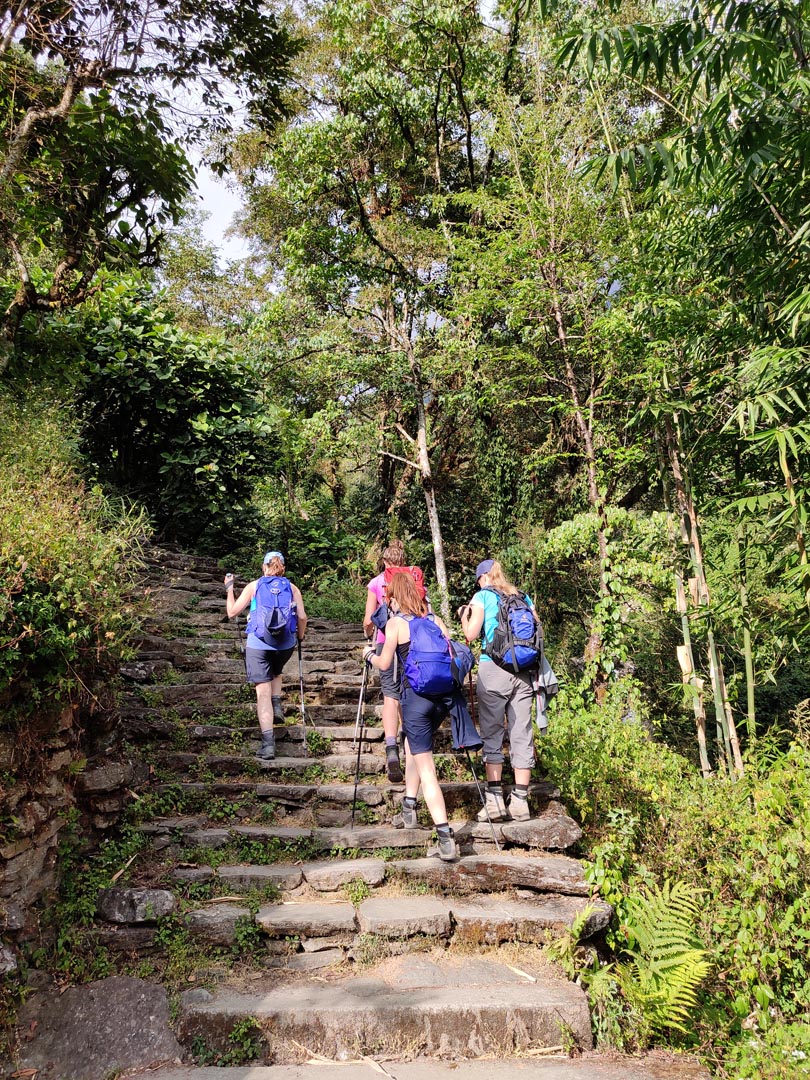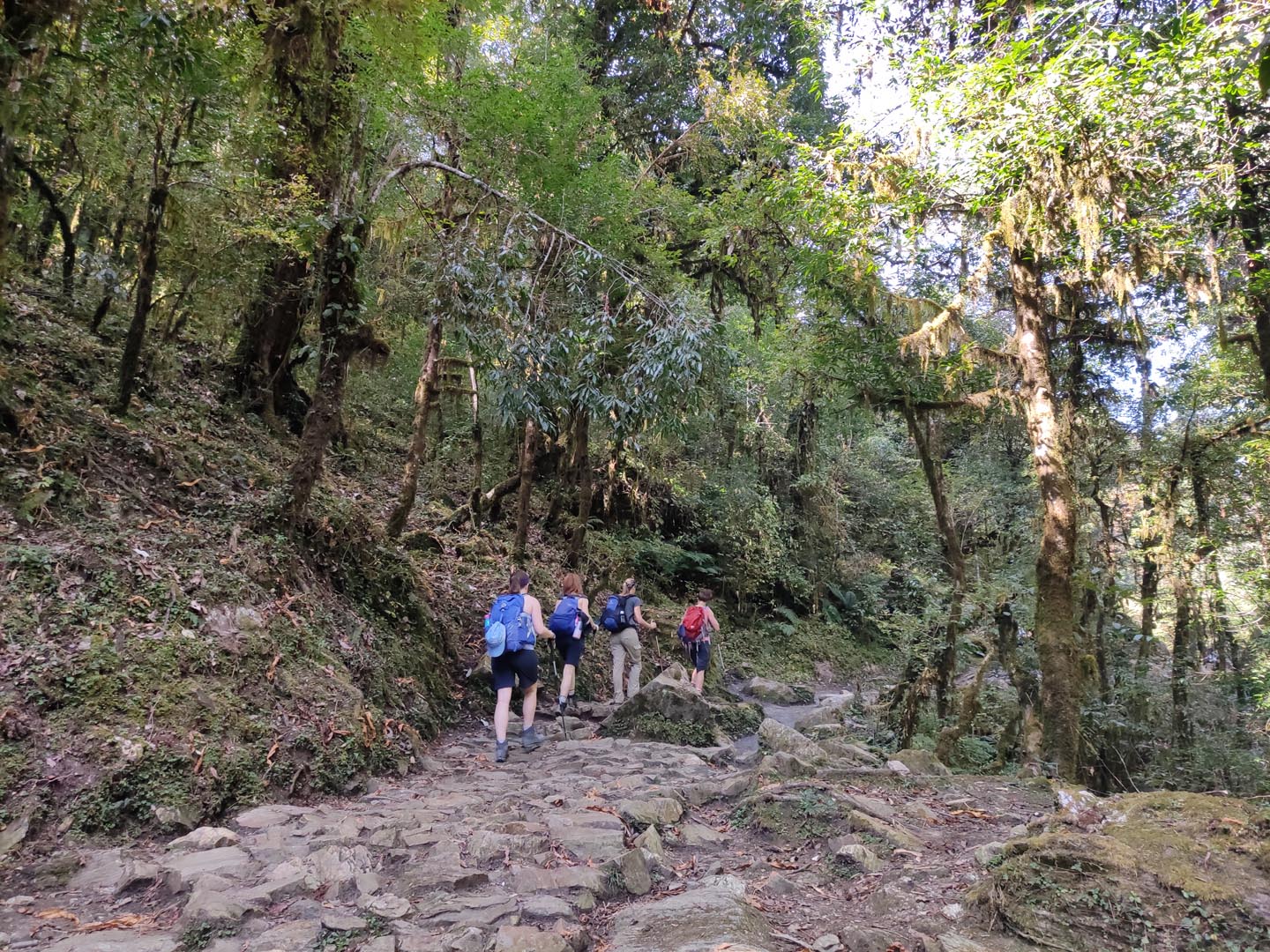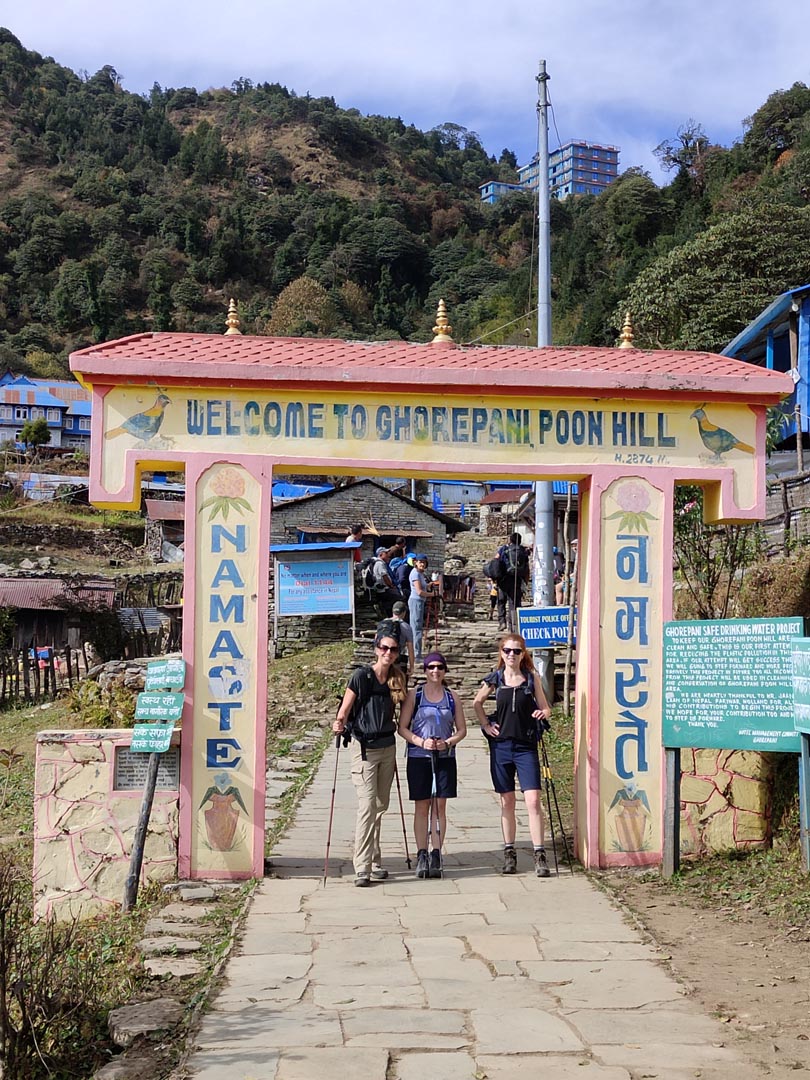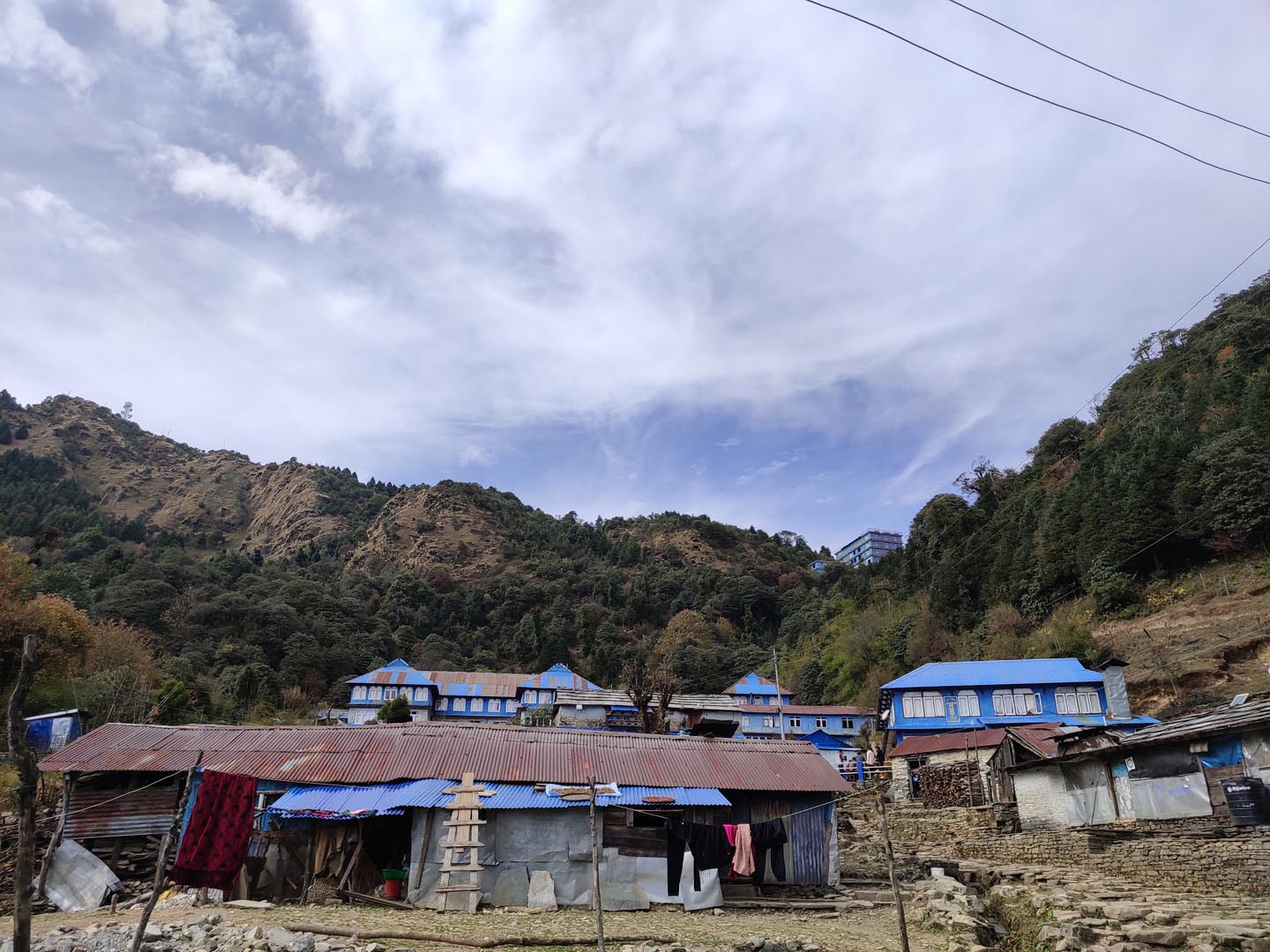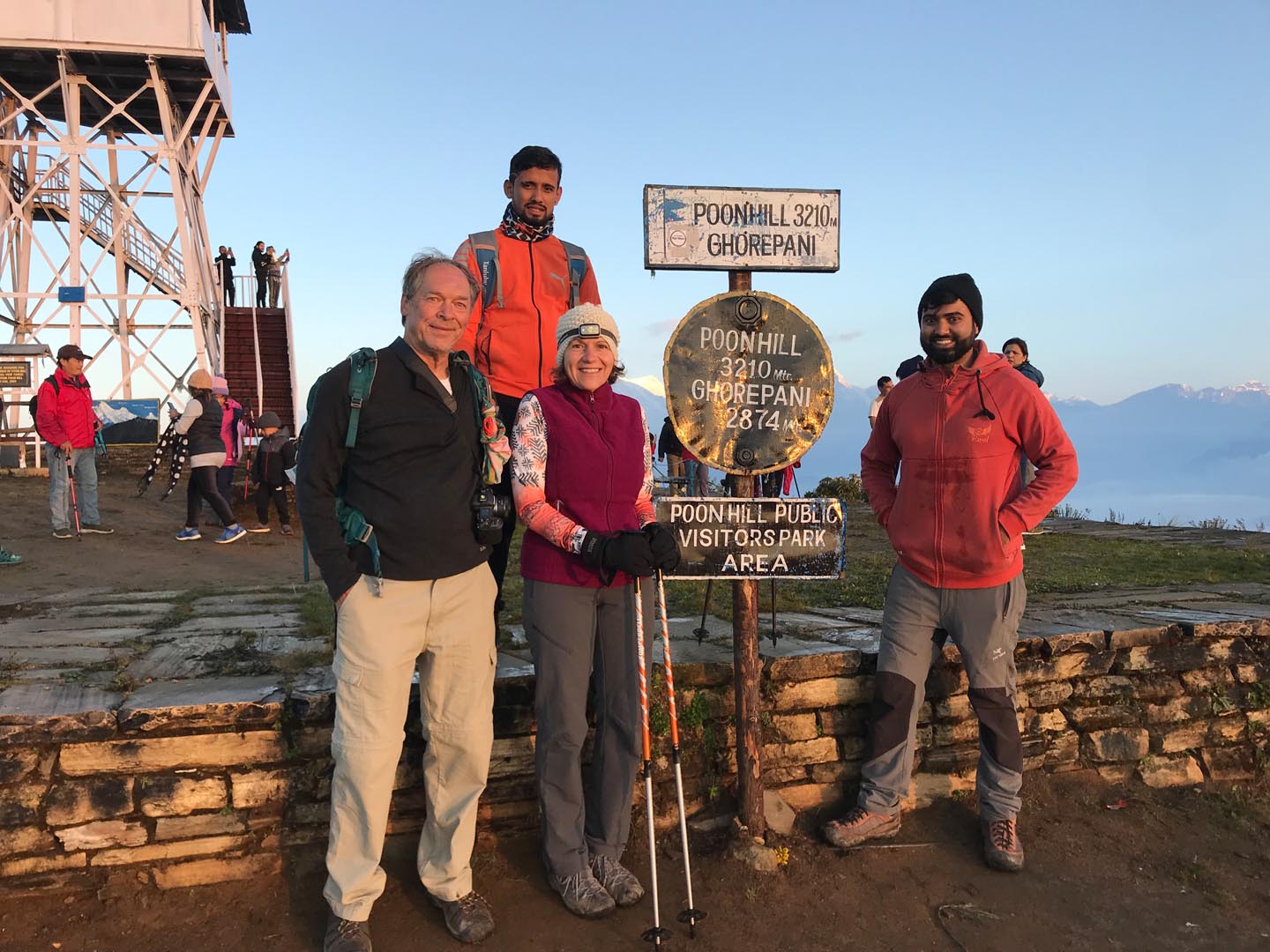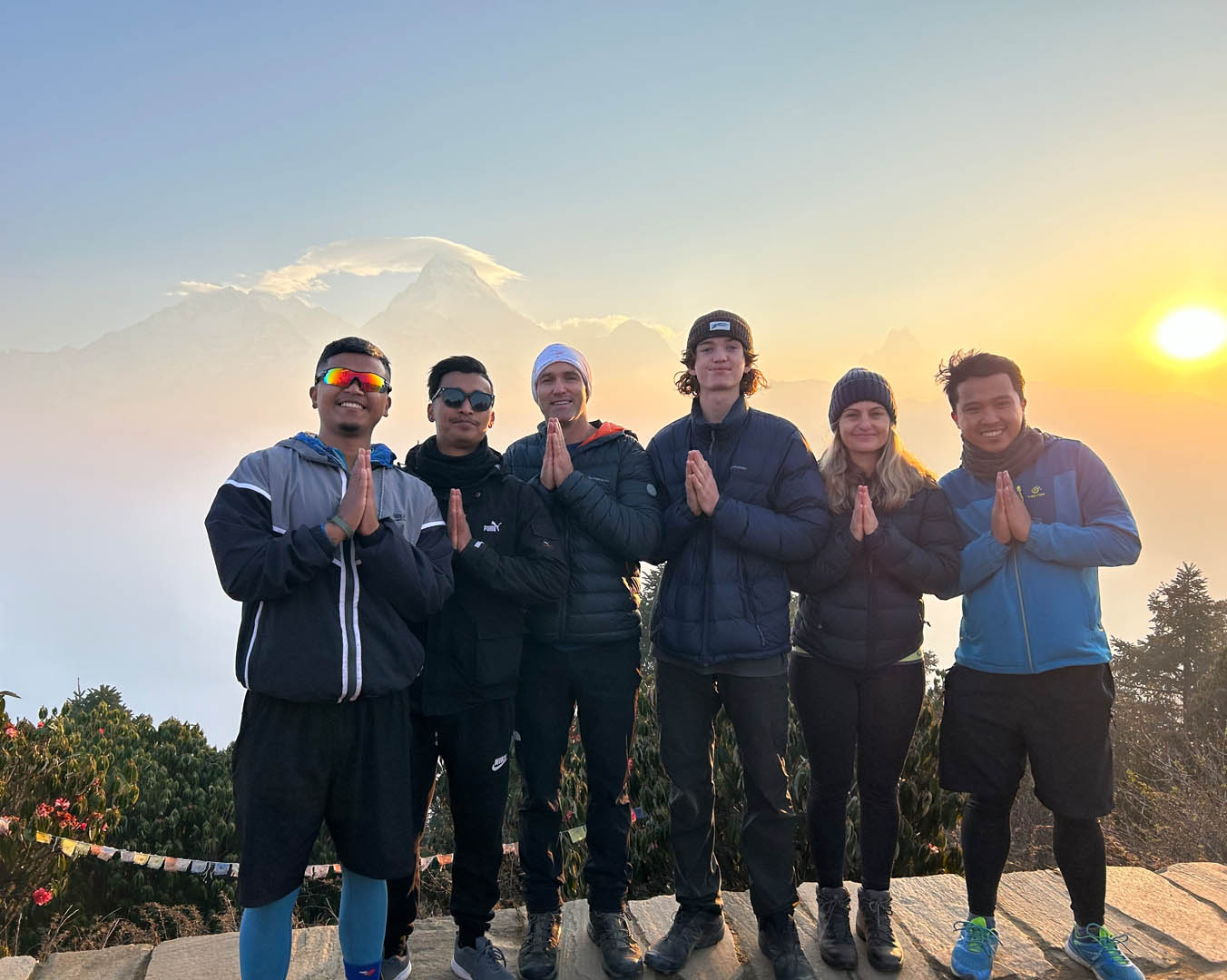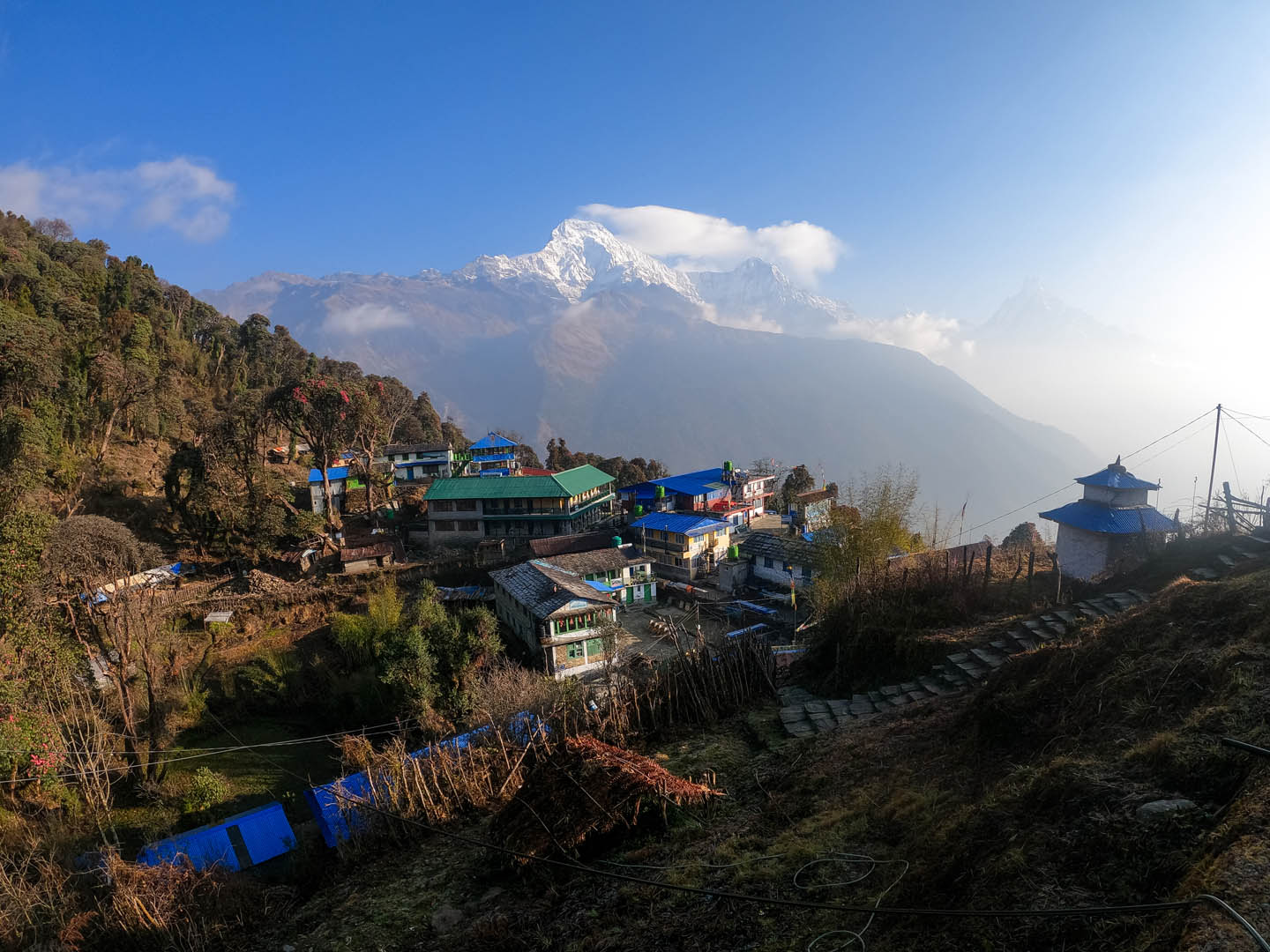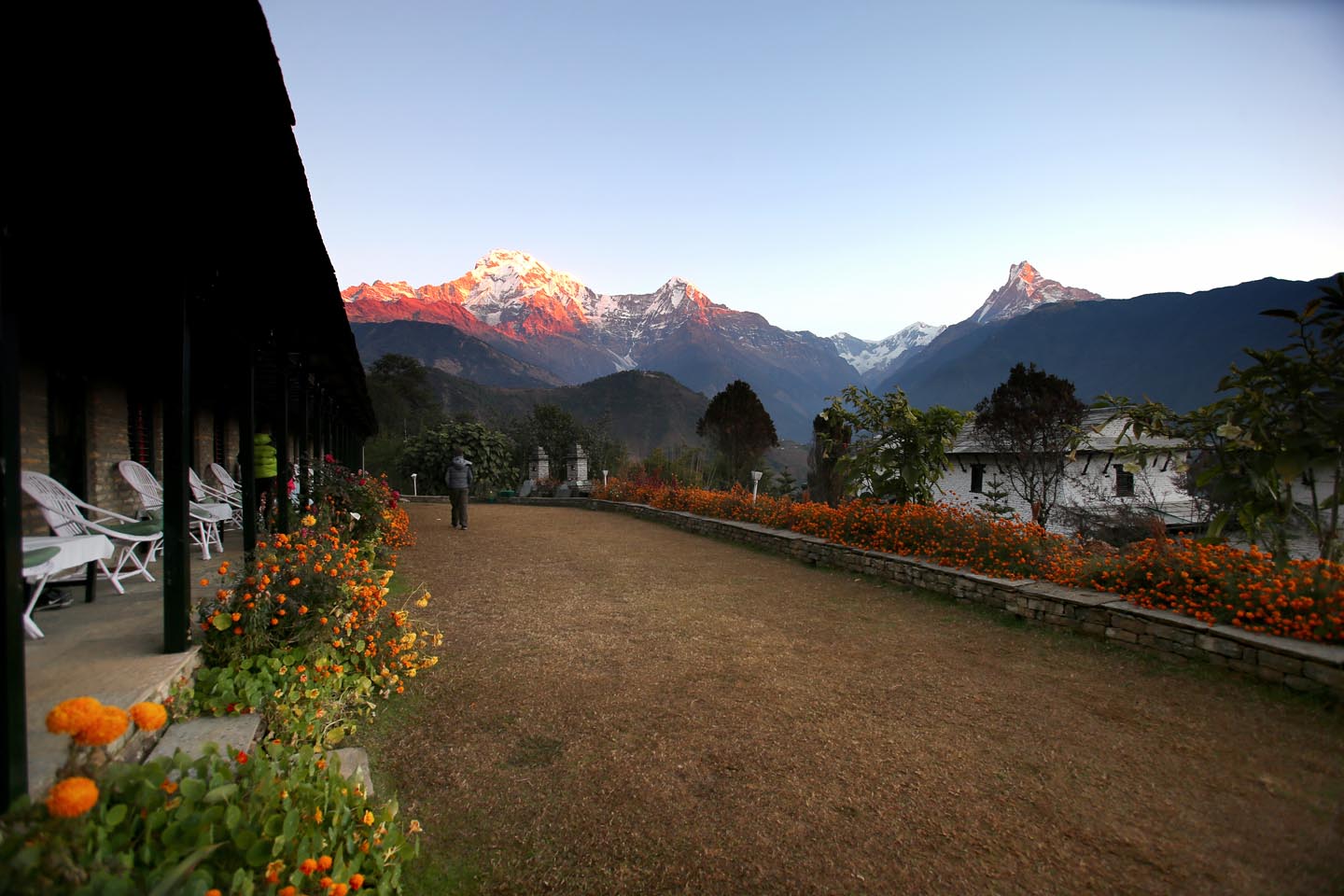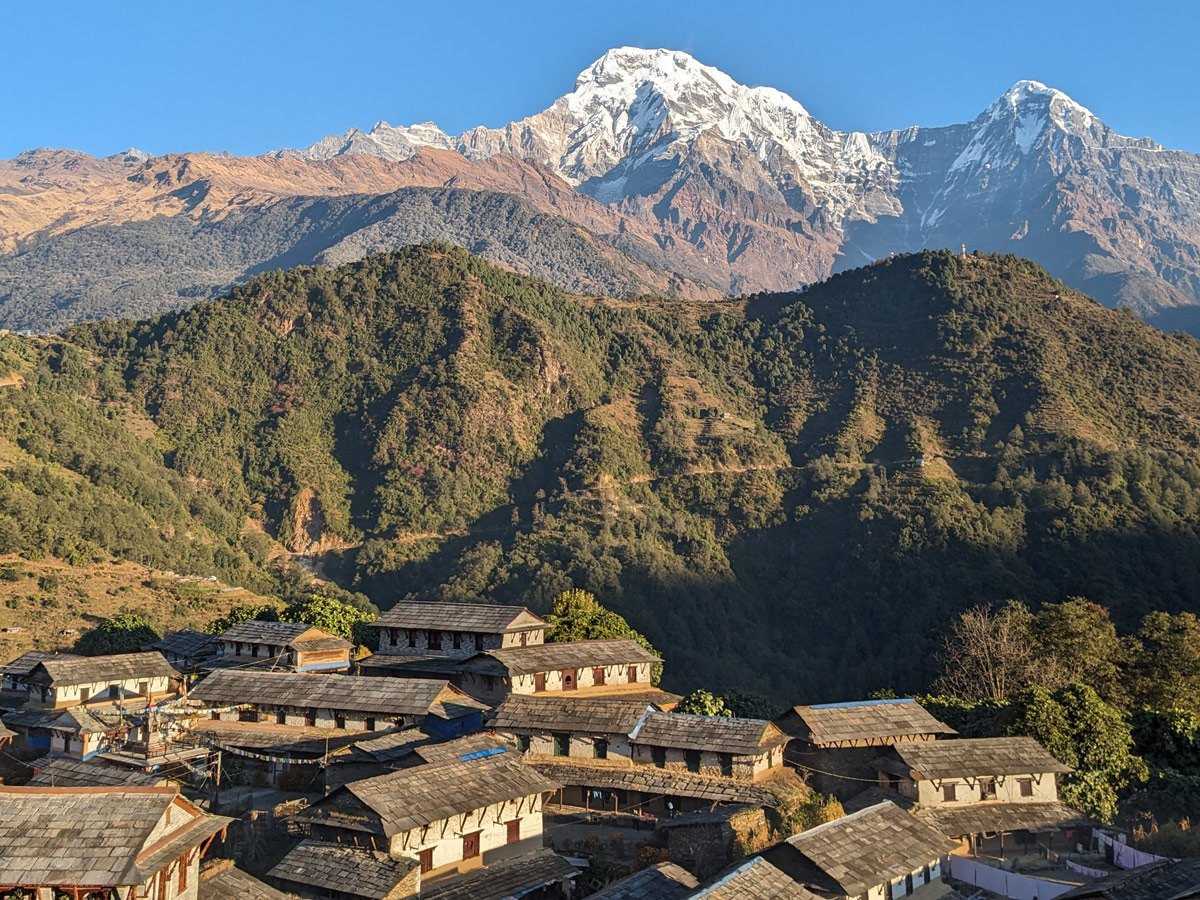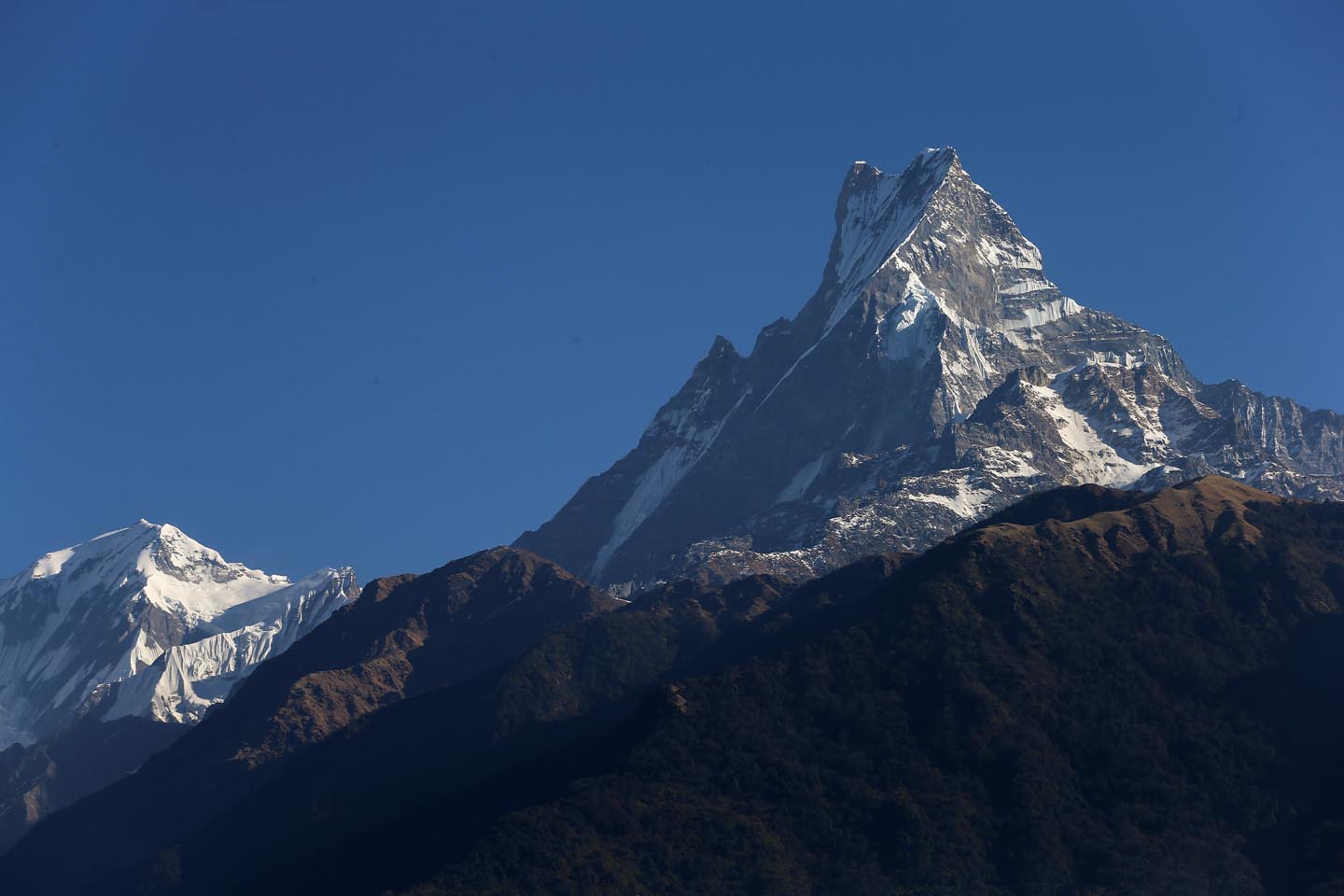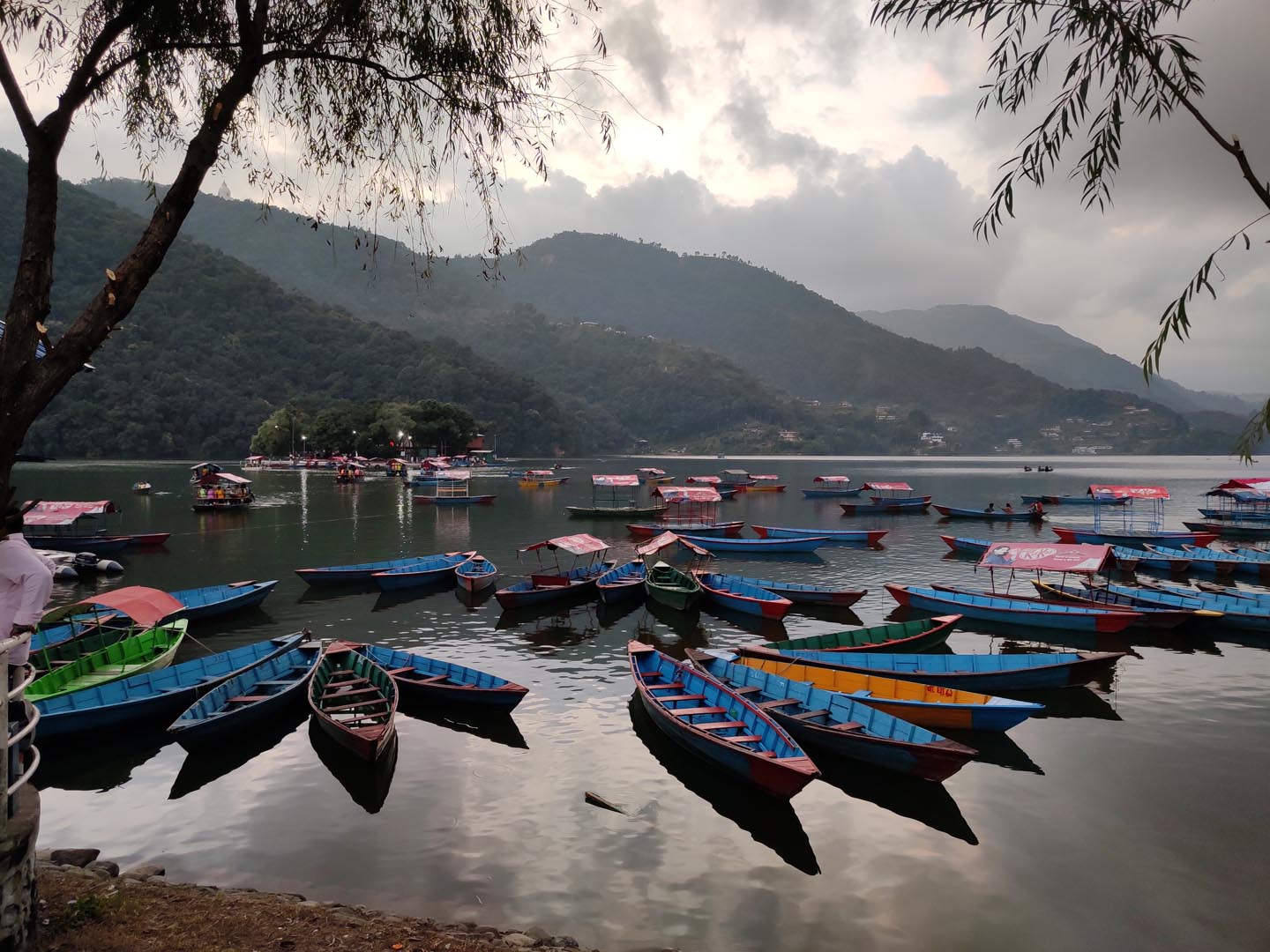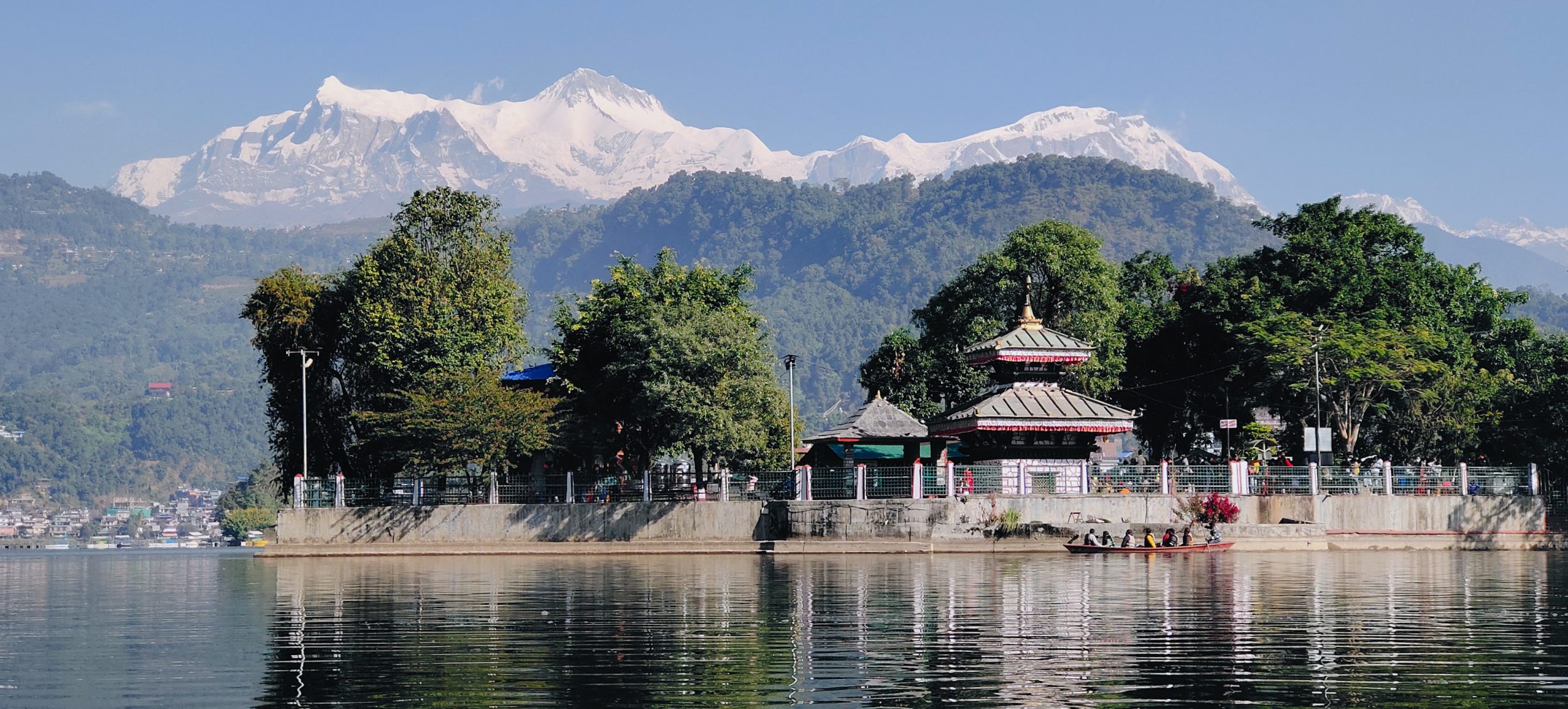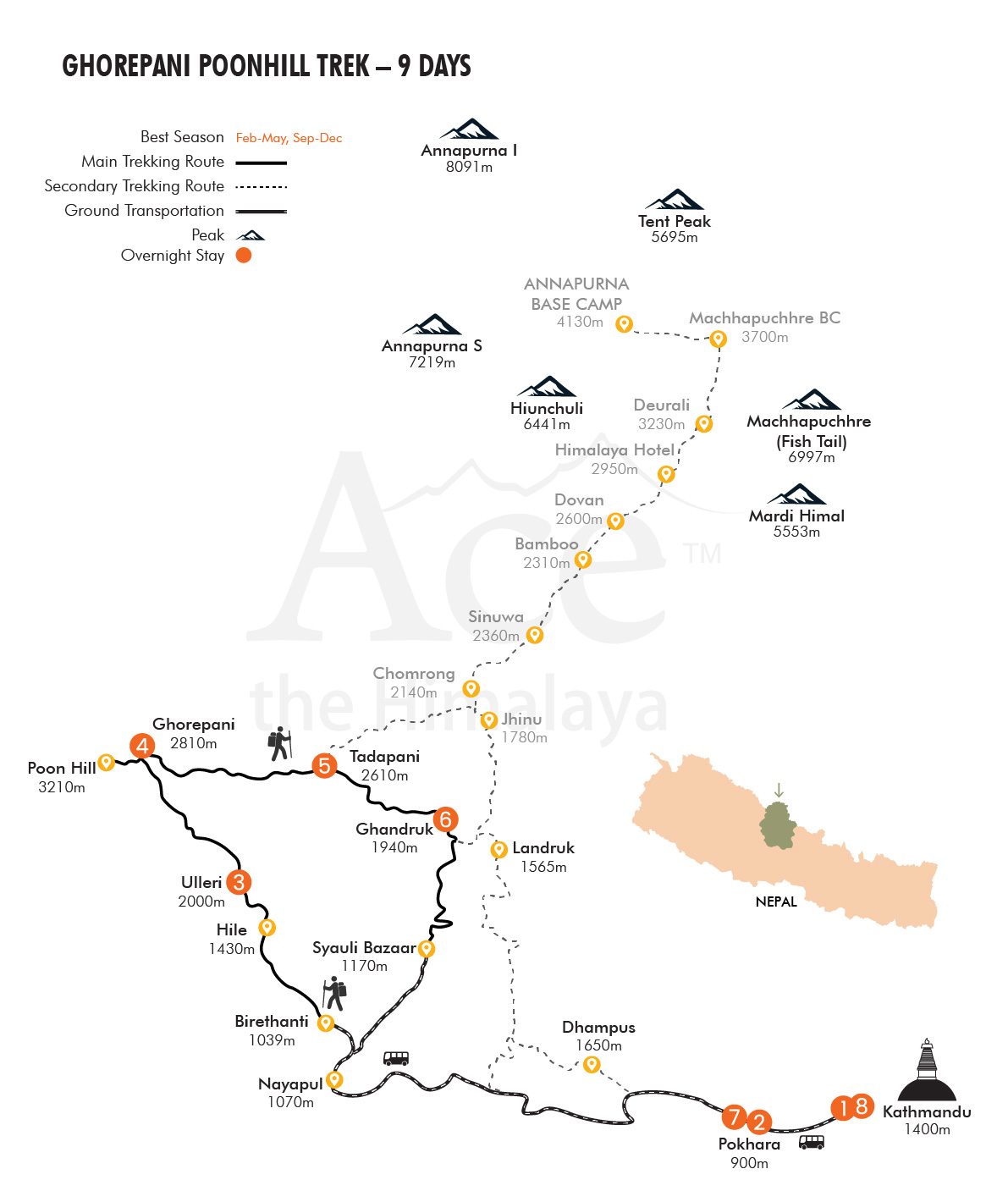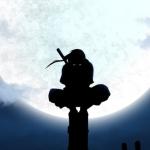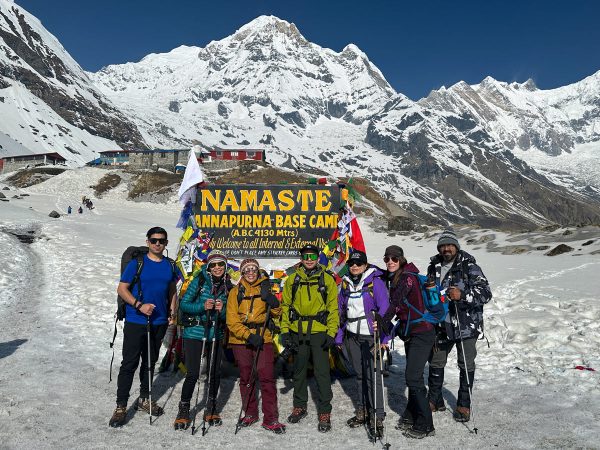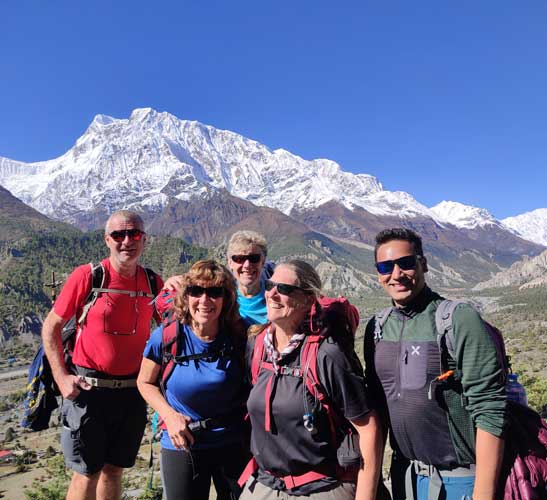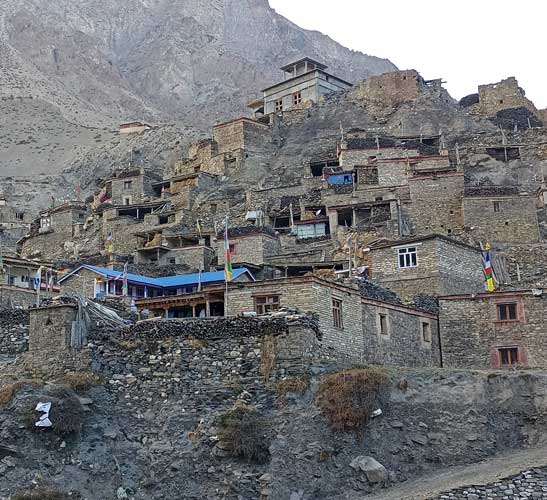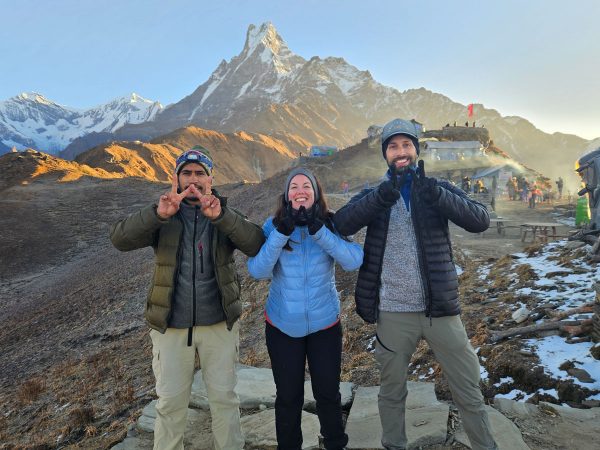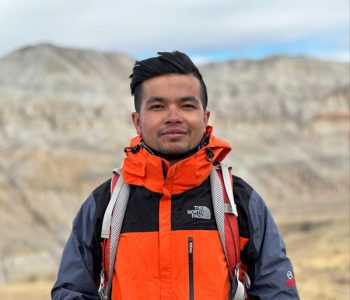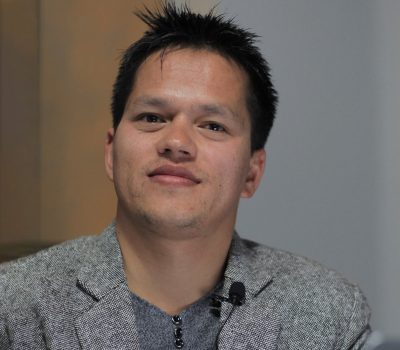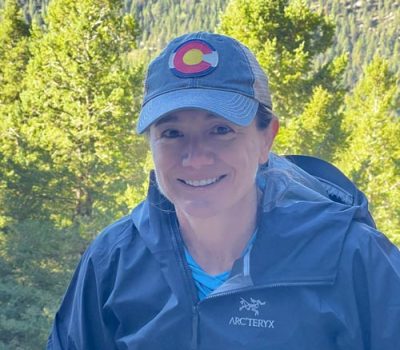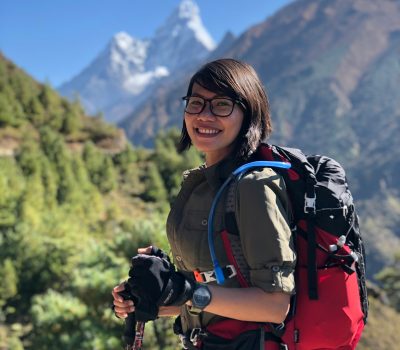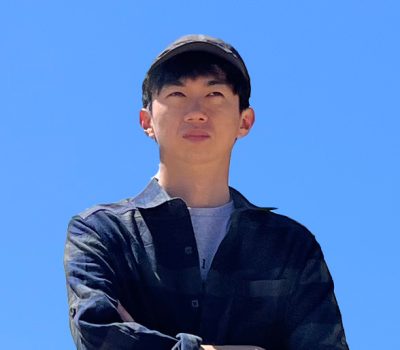Ghorepani Poon Hill Trek - 9 Days
| No. of people | Price per person |
|---|---|
| 1 Pax | USD 1,100 |
| 2-3 Pax | USD 800 |
| 4-9 Pax | USD 720 |
| 10-14 Pax | USD 650 |
Ghorepani Poonhill Trek is the most popular short trek in Nepal for its magnificent Annapurna Panorama and sunrise view from Poon Hill.
Highlights of the Poon Hill Trek
- Hike through lush rhododendron forests and terraced farms along the trails.
- Witness the enchanting sunrise at Poon Hill, casting a golden glow over the Himalayan peaks.
- Majestic view of the Dhaulagiri and Annapurna Mountain ranges.
- Immerse Yourself in Gurung Culture at Ghandruk Village
- Breathtaking Himalayan views without extreme altitudes
- Charming teahouse stays along the trekking route
Ghorepani Poon Hill Trek Overview
The Ghorepani Poon Hill Trek, starting and ending in Pokhara, transforms into a vibrant tapestry of color during spring and a snowy wonderland during winter.
This unforgettable adventure delves into the heart of the Annapurna region, offering a delightful contrast between peaceful valleys and challenging climbs.
Imagine traversing picturesque valleys adorned with terraced fields and dense mossy forests. But the true spring spectacle unfolds as you enter the vibrant rhododendron forests.
Blooming in a kaleidoscope of colors, these beautiful flowers create a breathtaking natural archway above your path.
Every turn on the trail offers a tantalizing glimpse of the high mountains, their snow-capped peaks teasing you with their grandeur. Poon Hill, the crown jewel of this trek, rewards you with unobstructed panoramic views of the majestic Annapurna and Dhaulagiri range.
Witness the sunrise paint the mountains in a mesmerizing display of golden hues, leaving you speechless with its raw magnificence.
The Ghorepani Poon Hill trek is an ideal option for those seeking a short yet rewarding Himalayan experience.
Completed within a week, the Ghorepani Poon Hill trek route offers a diverse landscape – from charming villages inhabited by Gurungs and Magars to refreshing river crossings and tranquil valleys.
The trails, though including uphill and downhill sections, are generally considered easy, making this trek accessible to a wider range of adventurers like you.
Poon Hill Trek Itinerary
Arrive at Tribhuvan International Airport in Kathmandu (1,400 m) and transfer to hotel. Overnight at hotel.
Drive to Pokhara (900 m) in a Tourist Bus – 7 to 9 hours. Overnight at a hotel in lakeside.
Drive to Birethanti (1,039 m) – 1 to 1.5 hours and Trek to Ulleri (2,020 m) – 4 to 5 hours. Overnight at a guesthouse.
Trek to Ghorepani (2,810 m) from Ulleri – 5 to 6 hours. Overnight at a guesthouse.
Early morning hike up to Poon Hill (3,210 m) & back, and then Trek to Tadapani (2,610 m) – 6 to 7 hours. Overnight at a guesthouse.
Trek to Ghandruk (1,940 m) from Tadapani – 4 to 5 hours. Overnight at a guesthouse.
Trek to Syauli Bazaar (1,170 m) from Ghandruk – 3 to 4 hours, Drive back to Pokhara – 2 to 3 hrs. Overnight at the hotel in lakeside.
Drive Back to Kathmandu (1,400 m) – 7 to 9 hours. Overnight at a hotel.
Transfer to the International Airport for Your Final Departure.
 Trip Note
Trip Note
Please be advised that extensive road construction along the Prithvi Highway from Kathmandu to Pokhara has resulted in increased traffic congestion and air pollution. As a result, the journey, typically taking around 6-7 hours, may now require approximately 8-9 hours. We appreciate your patience and understanding during this time.
Our standard itinerary might differ slightly due to unpredictable happenings and events out of our control. Factors such as flight cancellation/delay, unfavorable weather, natural calamities, newly implemented government rules, political affairs, trekkers’ health conditions, etc., are possible. Evaluating the situation’s possible solutions allow the trekking to resume as much as possible based on the best alternatives. In these times, we look for your cooperation and flexibility.
It is advised you arrive a day before the trip starts date so you can rest and it also gives you time to buy clothing equipment and gear required for the trek. Also, it is best if you book your international flights with spare days in Nepal before and after your trek in case of any flight delays or cancellations due to technical reasons. Moreover, you have options to customize this trip where you can add on a sightseeing tour in Kathmandu, Pokhara, other adventure sports or day trips around the country before or after the trek.
Departures & Availability
Our groups are small with maximum 14 people. We create groups of independent travelers, friends and families which maintains close interpersonal connection, engage more and get into depth of the journey. Choose a date from the calendar to reserve your spot.
| No. of people | Price per person |
|---|---|
| 1 Pax | USD 1,100 |
| 2-3 Pax | USD 800 |
| 4-9 Pax | USD 720 |
| 10-14 Pax | USD 650 |
Our groups are small with maximum 14 people. We create groups of independent travelers, friends and families which maintains close interpersonal connection, engage more and get into depth of the journey. Choose a date from the calendar to reserve your spot.
| No. of people | Price per person |
|---|---|
| 1 Pax | USD 1,100 |
| 2-3 Pax | USD 800 |
| 4-9 Pax | USD 720 |
| 10-14 Pax | USD 650 |
Looking for personalized experience? We organize privately guided journey which is mainly designed to fit your taste and interest. Please fill out the form below to get started.
Poon Hill Trek Package Includes
Accommodation
- Twin-sharing/double accommodation in a 3-star hotel in Kathmandu for 2 nights, including breakfast
- Twin-sharing/double accommodation in a 3-star hotel in Pokhara for 2 nights, including breakfast
- Twin-sharing or dormitory guesthouse accommodation during the trek in the Annapurna region for 4 nights
Meals & Drinking Water
- All your standard meals during the trek (Breakfast, Lunch and Dinner) including seasonal fruits
- A farewell dinner on the last night in Nepal
- Purified drinking water during the trek using water filter or water purification tablets.
Transportation
- All (international and domestic) airport transfers on a tourist vehicle
- Tourist bus between Kathmandu and Pokhara
- Private tourist vehicle from Pokhara to Birethanti and from Syauli Bazaar to Pokhara
Guide and Staff
- Experienced, first-aid trained, government licensed, English speaking, and locally recruited Ace the Himalaya’s trekking guide (2 guides for group size more than 7 people)
- Porters during the trek for carrying luggage (1 porter for every 2 clients)
- Wages, accommodation, meals, gear, insurance, and medications for all staff
Permits
- Annapurna Conservation Area Permit
- TIMS (Trekkers’ Information Management System) card
Benefits and Takeaways
- 1 Ace the Himalaya’s duffel/kit bag, trekking map, sun hat, Buff (Neck Gaiter)
- Trip completion certificate
Administrative
- All administrative expenses and government taxes
Price Excludes
- Meals (lunch and dinner) in Kathmandu and Pokhara
- International flight fare and airport departure tax
- Nepal Entry Visa (Visa can be acquired easily after your arrival at Tribhuvan International Airport in Kathmandu with a fee of USD 30 for 15 days visa, USD 50 for 30 days visa and USD 125 for 90 days visa)
- Travel insurance along with high-altitude emergency evacuation coverage
- Any beverages including bottled and boiled water
- Tips to trekking staff and driver
- Personal trekking gear and equipment
- Any expenses other than the Price Include section
Ghorepani Poon Hill Trek Itinerary
Expand AllDay 01: Arrival at Tribhuvan International Airport in Kathmandu and transfer to hotel
One of our officials will greet you at the Tribhuvan International Airport, Kathmandu, upon your arrival. We will take you to the hotel in our private tourist vehicle. Pre-trip meeting will be done and you will meet with your trip guide. Make sure to confirm your queries about trekking in the mountains.
Note: Pre-trip meeting will be done at the office if you arrive before 4 pm and in your hotel itself if you arrive later in the evening. Be sure to bring two copies of passport-sized photos and a readable copy of your travel insurance policy to the meeting. These documents help to acquire trekking permits and related documentation during the trek. Pay the remaining balance of your invoice and sign in the legally binding trip form and non-liability disclaimer.
Day 02: Drive to Pokhara in a Tourist Bus
Our trekking staff will pick you up from the hotel at 6:30 am and escort you to the tourist bus station. The journey to Pokhara, which departs around 7:00 am, offers picturesque views along the way.
As you travel, you’ll be treated to stunning landscapes featuring winding rivers and rolling hills, providing a captivating preview of the natural beauty awaiting you in the Annapurna region.
The city of Pokhara is also known for its panoramic views of Annapurna and Machapuchare (shape of fish tail) in the north, Dhaulagiri in the west, and Lamjung Himal and Manaslu in the east.
 Pokhara Road Update
Pokhara Road Update
Please be advised that extensive road construction between Kathmandu and Pokhara has resulted in increased traffic congestion and air pollution. As a result, the journey, typically taking around 6-7 hours, may now require approximately 8-9 hours. We appreciate your patience and understanding during this time. Alternatively, there is the option to take a 30 min flight from Kathmandu to Pokhara and vice versa. The cost for a one-way flight is USD 130 per person.
It is smaller and much less hectic than Kathmandu, hence providing the perfect starting point for our Ghorepani Poonhill trekking.
Day 03: Drive to Birethanti and Trek to Ulleri
Our journey begins with a scenic drive out of Pokhara in a private vehicle. After a 2 hours’ drive, we’ll arrive in Birethanti (1,039 m/3,409 ft). Here, we can stretch our legs and energize for the trek ahead with a delightful lunch stop at one of Hile’s (1,495 m/4,905 ft) many charming teahouses.
Hile, a quaint village nestled amidst the hills, boasts a vibrant atmosphere with a variety of shops. But today, its true charm lies in its welcoming teahouses, perfect for savoring a delicious meal and a steaming cup of tea.
After a refreshing break, we’ll continue our adventure with a short uphill hike to Ulleri, a large Magar village. This initial leg is designed to gently introduce you to the rhythm and beauty of trekking in Nepal’s stunning landscapes.
Day 04: Trek to Ghorepani from Ulleri
Our trek continues towards Ghorepani, a scenic village at 2,840 meters (9,318 feet). The climb eases from Ulleri, following a rhododendron trail through charming forests.
Keep an eye out for these colorful blooms, especially vibrant during the spring season; March and April.
We’ll stop at Banthanti (2,250 meters/7,382 feet) and Nangethanti (2,460 meters/8,071 feet) before reaching Ghorepani in about an hour.
Day 05: Early morning hike up to Poon Hill & back, and then Trek to Tadapani
Rise and shine for an unforgettable pre-dawn hike to Poon Hill (3,210 m/10,531 ft). This hour or two hike will be rewarded with a spectacle unlike any other.
As darkness gives way to light, witness the majestic Annapurna range come alive with the colors of sunrise. Poon Hill boasts an unobstructed panorama, offering breathtaking views of the high Himalayas bathed in golden hues.
Keep an eye out for the first flight of the day – a twin-otter plane – flying closely to the Poon Hill viewpoint.
After spending 1-2 hours enthralled by the sunrise spectacle, we retrace our steps back to Ghorepani for a well-deserved hot breakfast.
Refueled and energized, we embark this day’s journey to Tadapani. Be prepared for a series of uphill and downhill sections that test your endurance.
However, the ever-changing scenery and the satisfaction of pushing your limits will make it all worthwhile.
We’ll ascend to Thapla Danda (3,165 m) before turning off on the trail towards Tadapani. This final leg offers stunning mountain vistas, making the effort well worth it.
Day 06: Trek to Ghandruk from Tadapani
As you leave Tadapani behind, the trail takes a delightful turn, descending through verdant forests rich with flora and fauna.
Keep an eye out for colorful birds flitting through the branches and the occasional glimpse of the majestic Himalayas peeking through the canopy.
Your journey leads you to Ghandruk, a captivating village nestled amidst the foothills of the Annapurna.
This charming settlement serves as the home of the Gurung people, one of Nepal’s fascinating ethnic groups.
Immerse yourself in their unique culture, evident in their distinct dialect, vibrant traditional attire, and rich way of life.
Ghandruk boasts a proud history, being the birthplace of many Gurkha soldiers renowned for their bravery and skill. Ghandruk’s allure extends beyond its cultural heritage.
Its location offers breathtaking mountain views, making it a popular destination for trekkers. Explore the village at your own pace, soaking in the local atmosphere.
Day 07: Trek to Syauli Bazaar from Ghandruk and Drive back to Pokhara
Soak in the final panoramic sunrise view of the majestic Himalayas from Ghandruk, creating a lasting memory of your trek.
Following this spectacular finale, a 3-to-4-hour drive takes us back to the bustling lakeside town of Pokhara. The afternoon is yours to unwind and celebrate your accomplishment.
Stroll along the picturesque Phewa Lake, savoring the cool mountain air and the vibrant atmosphere.
Perhaps indulge in some local delicacies or browse the shops along the lakeside for unique souvenirs.
Day 08: Drive Back to Kathmandu in a Tourist Bus
We will be driving back to Kathmandu in the morning. In the evening, we host a farewell dinner in a fine restaurant where your guide(s) and an office staff will accompany you.
 Pokhara Road Update
Pokhara Road Update
Please be advised that extensive road construction between Kathmandu and Pokhara has resulted in increased traffic congestion and air pollution. As a result, the journey, typically taking around 6-7 hours, may now require approximately 8-9 hours. We appreciate your patience and understanding during this time. Alternatively, there is the option to take a 30 min flight from Kathmandu to Pokhara and vice versa. The cost for a one-way flight is USD 130 per person.
Day 09: Transfer to the International Airport for Your Final Departure
Our Ghorepani Poonhill trek concludes today. Our airport representative will drop you at the international airport in Kathmandu for your flight departure from Nepal.
Packing list for Ghorepani Poon Hill trek
Here is a list of what you might want to pack for the hike. Please take this as a starting point. You’ll need layers of warmer clothing during the winter. We provide a 75 liter duffel bag for you to use for the trek. It will be given to you during your pre-trip meeting in Kathmandu. The duffle bag is yours to keep. Also, you can rent sleeping bag and down jacket with us at the additional fee of USD 25 for each once you are in Kathmandu.
General
- Puffy down jacket (We have rental jackets available for an additional USD 25)
- Daypack (35-45 liters recommended) with rain cover
Upper Body
- Sun hat or cap (We'll provide you with a free Ace the Himalaya baseball cap.)
- Knitted hat/Beanie
- Scarf or neck gaiter
- Headlamp
- Sunglasses
Torso
- Technical fabric base layer (light for warmer months, heavy for colder months)
- Technical fabric short (2) and long sleeve (2) shirts
- Waterproof, windproof shell
- Fleece jacket or pullover
Lower Body
- Technical fabric base layer (light for warmer months, heavy for colder months)
- Hiking pants (2)
- Comfortable pants for inside the teahouses
- Waterproof/windproof outer shell pants
- Hiking shorts
Hands
- Wool or technical fabric liner gloves
- Hard-shell outer gloves (insulated for colder months)
Feet
- Wool or technical fabric warm socks
- Hiking socks
- Liner socks (optional such as silk)
- Trekking/hiking boots (waterproof recommended)
- Ice Cleats /Micro Spikes (For trekking from November to March, it's recommended to include Ice Cleats/ Micro Spikes to prevent slipping on icy or wet surfaces.)
- Casual shoes
Undergarments
Note: The quantity of each article of clothing can be adjusted to suit the preferences of each participant.
- Technical fabric/quick drying is best for underwear (opportunities to launder during the trip)
- Sports bras (women)
- Pajamas or sleeping clothes
First Aid Kits and Medications
- (Note: Guides carry medications and first aid kits during the trip. However, personal kits and medications are highly recommended.)
- Sunscreen
- Lip balm
- ointment
Other Essentials
- Passport
- Extra copies of passport-sized photos
- Reusable water bottle
- Toiletry kits
- Water purification tablets or UV water purifier (if you plan to treat water)
- Hydration bladder
- Towel
- Pillowcase
- Toilet paper (2 rolls)
- High protein snacks (such as protein bars or nuts)
- Waterproof/dry bags for carrying important documents and money
- Airline tickets (Please leave a copy at our office in Kathmandu. This can be useful if there is a change in the date of the flight.)
- Earplugs
- Trekking poles
Optional
Once in Nepal, if you have the time, you can purchase supplies and gear for hiking. Thamel, Kathmandu’s tourist hub, is home to many shops where you can get a variety of reasonably priced trekking equipment.
- Power bank or extra batteries
- Cameras and mobile phone
- Cards/book
- Pee bottle/ pee funnel for women
- Whistle
- Thermos for hot water
- Comb
Important Information
- We give you a free duffel bag and baseball cap during your pre-trip meeting in Kathmandu. The duffel bag will be used to pack your trekking supplies.
- For every two participants, we assign one porter. The duffel bag, which should weigh around 10 kg/22 lbs, will be carried by the porter throughout the walk.
- To carry your daily necessities like cash, crucial papers, a water bottle or bladder, a camera, toiletries, sunscreen, a notebook, clothing, etc., you must have your own daypack (with a waterproof cover).
- You can store your luggage (non- trekking items) at the hotel in Kathmandu.
- Down jacket with a hood is a must for altitudes above 4,000 m to keep warm. You can rent a down jacket for USD 25. Please note that in case of loss or damage, you need to reimburse the cost of USD 200 per item.
- You can rent a 4-season sleeping bag for USD 25. Please note that in case of loss or damage, you need to reimburse the cost of USD 200 per item.
Note: Some clothing, especially form-fitting, figure-hugging items made of elastic material (like yoga pants), may offend locals. Therefore, if you choose to wear these clothes for comfort, please make sure to wear something over them.
Ghorepani Poon Hill Trek Video
FAQs for Ghorepani Poon Hill Trek
General
Why trek with Ace the Himalaya?
Ace has a reputation for successfully leading treks with knowledgeable leaders and staff taking care of all your travel needs. We are a certified sustainable travel company that also endorses the idea of giving back to the community by participating in various philanthropic activities. Here are 17 reasons why you should choose Ace the Himalaya for your next adventure!
Is Nepal open to travelers following the Covid-19 pandemic?
Indeed, Nepal is entirely open. Travelers are welcome in Nepal without any restrictions. Arriving travelers can obtain a visa on arrival at the Kathmandu airport as well.
What are the conditions to travel to Nepal post Covid-19?
Traveling to Nepal is now hassle-free. You don’t need a vaccination certificate or negative PCR test, but check with your airlines and transit countries for any specific requirements.
We suggest you look at the Nepal immigration site https://www.immigration.gov.np for the most up-to-date information.
What additional documents do I need?
- Two passport-sized photos (2×2 inch) to give to our office staff
- A copy of your international flight ticket to give to our office staff
- A copy of travel insurance to give to our office staff
Do we book our own international flights to and from Nepal?
Yes, you need to book your own international flights. We are a local agent and it would cost you significantly higher to book through us. Please find more information in the International Flight page.
Is hiring a guide necessary even if I have trekking experience?
You can hike without a guide. A guide is there to assist you in going forward and making alternative plans and arrangements when unanticipated occurrences happen or when things get difficult. Our hiking leaders are qualified experts. When talking about their trip, our guests frequently remark on how much fun they had and how crucial their guide was to make it successful.
Can the guide speak English?
Yes, our guides can speak English. Most of them start their careers as porters and work for 3 to 4 years before becoming trekking guides. Their English skills are based on real-world experience rather than formal education. While they are able to communicate effectively, please note that English is not their first language, so their fluency may not be on par with native speakers. They will also assist with communication, especially since many locals, like shopkeepers and teahouse hosts, may not speak English.
Weather and Temperature
What is the best season for this trek?
Our trekking season extends from mid-September to May. From early September, the monsoonal rains decrease. By end of September to December, the weather is usually stable with mild to warm days, cold nights. February, March, April, May, June, October, November, December is the best time to do this trek.
What kind of weather and temperature can I expect while trekking?
One of the most unpredictable elements of the mountain is the weather. If you’re not properly prepared for the twists, turns and volatility of the conditions that can occur in this breathtaking region, you might find yourself in an uncomfortable and unpleasant situation. Here are some weather basics to help ensure that you come to the Himalayas as well equipped and prepared to face anything.
Generally speaking, the nights are much cooler than the daytime hours in the Annapurna region. Many first-time trekkers are surprised to learn about the incredible range that may occur in a given day. During the day, the thermometer could reach temps as high as 25 degrees C (77 Degrees F), only to dip down as low as -5 degrees C (23 Degrees F) in less than 24 hours. While there’s no way to know exactly what each day in the mountains will bring, the weather and temperature ranges tend to be somewhat predictable based on the month and season.
Spring – March / April / May / June
Spring happens to be one of the best times of the year to visit the Annapurna region. That is why, it can become somewhat crowded. The beautiful clear blue sky can be seen and the many different species of flower are visible in the lower altitude.
During springtime, the average temperature is 20 degrees C (68 Degrees F), with a maximum of 25 degrees C (77 Degrees F), during sunny days and a minimum of 0 degrees C (32 Degrees F), in the morning and at night for areas above 2500 meters.
July / August Through Mid-September is Monsoon Season
This season is not really recommended to travel as it rains in the lower altitudes. However, there are positive sides of trekking during the monsoon months. The excess rainfall can provide ample chance to see spectacular views of the waterfall and it’s also the best season to avoid the crowds.
During this time, the average temperature is 25 degrees C (77 Degrees F), with a maximum of 30 degrees C (86 Degrees F), during sunny days and a minimum of 5 degrees C (41 Degrees F), in the morning and at night for areas above 2500 meters.
Autumn – End of September / October / November
Similar to springtime, autumn in this region is also a crowded season. But it’s one of the best times to trek. While it lacks the beauty of flowers, the clear blue sky can be seen, affording incredible views from just about every angle.
The average temperature during the fall is 20 degrees C (68 Degrees F), with a maximum temp of 25 degrees C (77 Degrees F), during sunny days and a minimum of -5 degrees C (23 Degrees F), in the morning and at night, for areas above 2500 meters altitude.
Winter- December/ January/ February
Winter start from mid-December till mid-February in this region. People still like to trek in this month due to fewer crowds.
The average temperature during the winter is 10 degrees C (50 Degrees F), with a maximum temp of 17 degrees C (62.6 Degrees F), during sunny days and a minimum of -10 degrees C (14 Degrees F), in the morning and at night, for areas above 2500 meters altitude.
The temperature mentioned above is based on the outdoor temperature of the guesthouse temperature. No need to worry about the cold temperature as we provide the sleeping bag plus an additional blanket to make sure our clients are warm enough during the time of need.
What is the temperature rating of the sleeping bag that you lend to trekkers?
The temperature rating of the sleeping bags that we rent to trekkers is about -10°C (14°F). Also, our guides can obtain extra blankets if needed at the teahouses.
Arrival and Visas
Is it possible to obtain a visa for Nepal upon arrival at the airport?
Yes, you can obtain a Nepal visa upon your arrival at the airport. There are kiosks in the arrival hall that you use to complete the necessary forms. The cost is USD 30 for a 15-day tourist visa, including numerous entries, or USD 50 and USD 125 for a 30-day or 90-day tourist visa including numerous entries respectively. You should carry cash (USD) with you to pay your visa fees quickly and easily, as digital payments are frequently unavailable.
To save time, we recommend filling out the online visa application form in advance. Applying online 2 weeks before your arrival will expedite the process at the airport. For detailed guidelines, please refer to our blog titled Guidelines for Online Tourist Visa Form in Nepal.
Who will come to pick me up at the airport upon my arrival?
Our staff will be waiting for you outside the airport terminal with our signboard (Ace the Himalaya). You will be accompanied to a hotel in a private tourist vehicle.
Payments and Extra Costs
How much additional money do I need per day?
Typically, USD 15 to 20 per person per day will be sufficient. This is to purchase water, tea/espresso, snacks, and hot showers in the mountains and for lunch or dinner in Kathmandu. Additionally, if you want to buy souvenirs or native Nepali goods, you can bring extra cash with you.
Is it possible to use credit cards in the places I visit during the trek?
In Kathmandu and Pokhara, yes – to some extent. Once you are out of the cities, all you need is cash. Please change the currency in local Nepali Rupees before you go to the mountains.
Is it possible to reserve a trip now and pay a deposit later, or do I have to pay a deposit at booking/reservation?
When you book, you must pay a 30% deposit to secure your itinerary. The remaining balance can be paid upon your arrival at Kathmandu or before arrival. US Dollars cash and credit cards (Visa, Master, and American Express) are accepted once in Nepal. Please note a 4% transaction fee will be added for all credit card transactions.
How are the ATM and money exchange facilities in Kathmandu?
There are ATM and money exchange facilities almost every few meters in Thamel, where you will be staying in Kathmandu. So, you can easily use your cards to cash out limited sum of money to which a minimum charge is deducted by the ATM facility itself. You can easily exchange your foreign currencies in currency exchange centers for an exact rate.
How do I pay the remainder of my balance upon arrival in Kathmandu? US Dollars cash or credit card?
You can make payments via US Dollars cash or credit card (Visa, Master, and American Express). A 4% transaction fee is added if paying with a credit card. Thus, we encourage you to pay with USD cash if you are planning to pay upon your arrival in Kathmandu.
We prefer you pay with larger bills (USD 50 or 100). Please note that the cash should not be older than 2009 and in good condition, as banks do not accept worn, torn, or crumpled bills.
Who Can Trek?
How difficult is the Ghorepani Poon Hill Sunrise Trek for beginners?
The Ghorepani Poon Hill Trek is considered a moderately easy trek, making it suitable for beginners with a basic level of fitness. The trail offers a gradual ascent with well-maintained paths and well-marked trails.
While there are some uphill sections, they are manageable for most hikers, and the trek includes plenty of rest stops along the way. The highlight of the trek is the rewarding sunrise view from Poon Hill, which serves as an excellent motivation for trekkers of all levels.
With proper preparation and acclimatization, beginners can confidently enjoy this mesmerizing adventure in the Annapurna region.
Are there any age requirements for mountain trekking?
Our treks have no age restrictions if members are healthy and willing. We have had families with kids as young as 5 years do the treks along this region, and our oldest adventurers have been in their late 70s.
Is trekking to mountain regions safe for solo female travelers?
It is safe for a female to trek alone in Nepal. Nepal is usually regarded as a safe nation for female visitors traveling alone. It is entirely safe for a solo woman to trek with Ace the Himalaya on any of our treks.
Physical Fitness
What kind of physical training is necessary for trek preparation?
For trekking, you must prepare your body to walk over uneven, hilly landscapes while carrying a backpack. Walking at an incline, jogging, cycling, and going for long-distance hikes are all good ways to exercise. You should work out for at least one hour four to five times a week for at least two months before trekking.
How quickly do you walk on the trail?
The average walking speed for a reasonably fit person is 4 kilometers per hour. At higher elevations, it is highly recommended that you walk slowly to help with acclimatization.
What are the physical standards that I need for the trek?
Participants in good physical condition should be able to complete this trek. If you are not physically active, we advise starting an exercise regimen two months before the trek that includes at least an hour of walking at an incline, running, or biking four to five times a week.
Incorporating hiking into your workouts is ideal. It is advised to speak with a doctor before making travel arrangements if you have any health conditions that could affect your ability to complete the trek.
Trek Preparation and Packing
What are the procedures after I make my deposit?
After making the deposit, one of our staff will email you for further information. We will require a copy of your passport photo page and your arrival/departure flight details. We will also provide you with additional trip information.
What sort of insurance do I need? How can I obtain a policy?
Travel insurance is mandatory for our hiking itineraries. We require your policy have medical evacuation coverage for the maximum elevation of your itinerary. Insurance may also cover additional costs in the event of a flight delay or cancellation caused by bad weather, medical costs, theft, loss, and damage to your items while traveling.
Travel insurance can be obtained online by one of several travel insurance companies. Please note that insurance obtained from an airline at the time of booking your flight may not cover medical evacuation coverage.
What are the necessary items that I should pack for my trip?
You can find the necessary items to pack for the trek here on the Equipment section. Gear and equipment can be bought or rented upon your arrival in Kathmandu. If you plan on buying or renting gear in Kathmandu, please allow extra time.
Do you provide sleeping bags or down jackets for rent?
Yes, we do provide sleeping bags or down jackets for rental costs of USD 25 each. Do let us know before initiating the trek and we shall provide items.
What type of bag will the porters carry?
We provide you with a free duffel bag of 70 to 80-liter capacity that our porters will carry. The maximum weight that porters can safely carry is 30kg, and each porter is assigned to two people.
However, each porter carries a maximum of 25 kg/55 lbs in total during the trek period. Your duffel bag, which should weigh no more than 12.5 kg/27.56 lbs per client, will be carried by the porter throughout the trek.
What type of daypack should I bring?
We suggest a 30 to 40-liter capacity daypack. Wider straps and hip belts are recommended to assist you in carrying weight evenly and reduce pain.
What about my passport, medications, and belongings?
Bring copies of your passport, insurance papers, and other essential items in your carry-on during your flight. If you need to take medications daily, keep them in your daypack with your other essential possessions. You can store other non-trekking essentials in the office of Ace the Himalaya or at the hotel in Kathmandu.
Will there be a place to store items/clothing not required for the trek?
The hotel in Kathmandu and Pokhara does provide the free storage services. So, you can leave all your items that are not required for the trekking at your hotel.
Do you use porters on the trek or do we carry all of our own gear?
Whilst on the trek, our porter will take care of your luggage. All you need to carry is your small day bag for your personal belongings like camera, water bottle, sun cream etc.
Accommodation
What kind of lodging is available in Kathmandu, Pokhara, and on the trek?
In Kathmandu and Pokhara, we use three-star hotels including breakfast. We use Hotel Thamel House, Gaju Suite Hotel, Hotel Jampa, or comparable-class lodging in Kathmandu. Teahouses with clean rooms are used during the trek. For further information see Teahouses in Annapurna region.
Are the guesthouses heated?
The guesthouse does not facilitate with heater or air conditioner. However, as it gets colder above 3,500m, they do have facility of hitting the dining area by providing kerosene or metal heater. USD 1 to USD 3 per person would be applicable to use this service and this is payable directly to the guesthouse.
What are the Toilet facilities in the tea house/guesthouse?
Most of the tea houses do have western style flushing toilet however in higher elevation you could find the squat toilets made of either a ceramic basin on the ground or few planks precariously positioned over a hole in the ground which is always outside of the room.
Is it possible to have private rooms while trekking or while in Kathmandu?
A private room in the teahouses cannot be guaranteed during peak season. During the non-peak season, the teahouses may provide a private room without any additional cost. The accommodation during the trek will remain very basic with twin sharing rooms and occasionally dormitory rooms for our trekkers.
We can arrange for a private room while in Kathmandu and Pokhara for an additional cost of USD 35 per room per night.
Is it necessary to bring toilet paper for the trek?
You can buy toilet paper in the guesthouses during the trek, but it can be expensive, so we suggest you bring some with you. You also need to bring personal items such as towels, soap, hand sanitizers, and so on.
Will there be a place to store items/clothing not required for the trek?
The hotel in Kathmandu and Pokhara does provide the free storage services. So, you can leave all your items that are not required for the trekking at your hotel.
Where do we go to toilet along the trail?
There are toilet facilities in the teahouses/lodges during the trek. Trekkers can also find private areas along the trail for emergencies.
What sort of food can I expect in Ghorepani Poon Hill trekking?
Most teahouses (lodges) in Ghorepani Poon Hill trek trails cook a delicious range of mostly vegetarian fare. Pasta, tuna bakes, noodles, potatoes, eggs, daal bhat (rice and lentils), bread, soup, fresh vegetables (variety depends on the season) and even some desserts like apple pies, pancakes, and some interesting attempts at custard.
You will find a lot of garlic on the menu because it assists with acclimatization – eat some every day. In many villages, you may find some meat items on the menu. You can always get hot chocolate, tea, and hot lemon drinks, as well as soft drinks, and treats like chocolate and crisps.
Each day dinner and breakfast will be at a lodge you’ll stay at while for the lunch you would be stopping by on the way where you can order your meals as per your choice. Guide will help you to stop by at best possible places to eat.
I'm a vegetarian. Is that a problem?
Most of the teahouses in the mountains offer vegetarian meals. So, being a vegetarian is not a problem. Vegetarian meals are preferable to avoid food poisoning and indigestion.
Is the food in the mountains prepared to international standards in terms of safety?
Indeed, the guesthouses follow international guidelines while setting up the food and serve you clean, protected, and warm meals.
Is the water available drinkable? Do I need to bring purifying tablets/filter?
The trip price included the drinking water for the all Bhutan trip. You don’t need to bring any bring purifying tablets/filter or pay for the water.
Can we get hot or boiled drinking water? Does it cost extra?
Yes, teahouses do provide hot boiled water for an extra charge of USD 2 to 5 per liter. The cost varies and increases at higher altitudes.
Can I shower/bathe during the trek?
At the lower altitude the guesthouses provide the facilities of hot shower.
And in rest of the places (at higher elevation), warm water in the bucket will be provided for shower.
For all above showers, it would cost you extra about USD 5 to 8 per shower. The higher you go the hot shower would be expensive.
What happens if I end up staying an extra night/s in Kathmandu due to an unforeseen delay or cancelation?
In case of unforeseen circumstances such as flight cancellation, your health, or for any reason you decide to discontinue the trip and arrive early in Kathmandu then you will need extra accommodations in Kathmandu. The cost of the teahouses in the mountains is not equivalent to the cost of a hotel in Kathmandu. In such cases, we will arrange your accommodations, but you will need to pay a supplemental charge.
Can I charge my electronic equipment during the trek?
Yes, you can charge your equipment during the trek for an additional cost. The cost will vary but is around USD 1-5 per charge. Two pins (type C) and three pins (type D) adaptors are highly recommended. Bring these adaptors or purchase them while you are in Kathmandu.
Health and Safety
Do your guides have the trekking guide certificates from the Hotel Management and Tourism Center? Have they received first aid training for high altitudes?
We provide licensed trekking guides with fluent English. Our guides are certified by the Hotel Management and Tourism Center after receiving 45 days of training. Similarly, the guides receive high-altitude training from Kathmandu Environmental Education Project (KEEP).
What are safety measures in place? What safety equipment do your guides carry on the trek to deal with sickness/accidents?
Our guides are well trained and certified in first aid. Throughout the journey, our guides will evaluate your condition and your oxygen level using an oximeter. Our head office receives continuous updates on your condition and location through the guides. In places without a phone signal, your situation will be updated through a satellite phone during emergencies.
How do you allocate guides and porters in a group?
We allocate one guide for groups of up to 8 participants. For groups of over 8 participants, we allot an associate guide. As per the size of the group, we may add more guides or divide them into sub-groups.
We provide one porter for every two clients. Two clients’ duffel bags will be carried by one porter. The weight limit is 25 kg (55 lbs) or 12.5 kg (27.56 lbs) for each client. For an additional cost, we can arrange for one porter to carry one participant’s duffel.
Is Ace the Himalaya's staff insured?
Our company insures all our trekking staff members, including guides, cooks, Sherpa, and porters. Please browse through our legal docment page to view insurance details.
What vaccinations will I need?
While no vaccinations are strictly mandatory for travel to Nepal, it is highly advisable to take precautionary measures to protect your health. To ensure a safe and enjoyable trip, we recommend the following vaccinations: Routine Vaccines, Malaria, Japanese Encephalitis, Hepatitis A, Hepatitis B, Typhoid, Rabies, Cholera, etc.
It is also helpful if you inform us of any medical condition that is relevant so we may convey this information in the event of an emergency. Ace the Himalaya keeps your medical condition confidential unless treatment is necessary.
What if I am very sick in the mountain?
Our guides are 24 hours available for the services during the trek. They are trained to use first aid kit and have knowledge to use Oxy meter. They are very much aware that higher the altitude the oxygen level gets lesser so to get updated on the oxygen level of our client and to know whether they are fit enough or needs extra precautions to continue.
Guides carry local sim cards both Nepal Telecom and Ncell in order to update whereabouts and situation of our every client. During the time of emergency our guides are alert and keeps updated to head office in Kathmandu that is available 24 /7 to arranging from horse to mules or helicopters in the must needed cases especially when client is seriously sick in the mountain and needed to be hospitalized.
What is necessary for sun protection during the trek?
Even when the sun isn’t shining, sun protection is essential. UV rays are reflected by the snow and the harshness of the sun will damage your skin before you notice it at high elevations. Therefore, proper clothing and sunblock are necessary. Hat, sunscreen, sunglasses, clothes, etc. are vital for sun protection.
What kind of trekking boot would be best for the trek?
An important piece of equipment is your trekking boots. Invest in a durable and comfortable pair, preferably with water-proof lining. Boots that provide ankle support on rough ground and have stiff soles are recommended.
Do you guys have a PAC (Portable Altitude Chamber)?
Yes, we have access to a portable altitude chamber in case of an emergency. It is not essential to carry during the trek. Though, we can use arrange it upon request for an extra cost of USD 200.
Practical Matters
What is your cancellation policy?
Notice should be provided 20 days before the trip start date in case of cancellation. The trip can be canceled for justifiable reasons. Once the trip is canceled, a fee of 30% of the trip cost is retained for administrative costs.
However, the trip amount is entirely non-refundable if the cancellation is not made before the 20 days as per our terms and conditions. For submitting a claim to your insurance company after the cancellation, we can assist with documentation such as a receipt of monies paid. Refund will not be provided for unused accommodation in case of trip cancellation caused by personal reasons/sickness/weather.
More information about our cancellation policy can be found here in Terms and Conditions page.
Do I need to tip my guide and porter? How much would that be?
Tipping is both expected and appreciated, and it reflects your satisfaction and enjoyment of the trek. We recommend tipping based on the number of participants in your trekking group and the duration of the trek. As a general guideline, consider allocating at least 10% of your total trek cost for tipping. Detailed tipping recommendations for your guides and porters will be provided during our pre-trip briefing in Kathmandu.
Is there any communication while we are trekking?
Yes. The guides carry local cell phones, so you can use their cell phones if necessary and reimburse them. Assuming you have brought your cell phone, you can obtain a local SIM card and use it. Our guides or representatives can help you get a local SIM card after your arrival. There is the availability of Wi-Fi at most teahouses for an additional cost. We utilize satellite telephones for emergencies.
Does it cost an extra amount if I am a solo traveler?
If you are a solo traveler and book one of our published dates, there is no additional fee. If you sign up for a private trip or change the trip date from one of our published trip dates, you will be charged an additional fee.
Is there a provision for a refund policy if I don't accomplish the trek?
Trekkers occasionally fail to complete the journey for medical or personal reasons. In this situation, be aware that we do not issue any refunds for products purchased or unused trek days. We must pay our administration staffs, guides, and porters, purchase trekking permits, and all other booked accommodations in advance, so our expenses remain the same.
Who else will be joining my trekking group?
If there are any, you will be allocated to a trekking group. The details of the personal data of your group members cannot be disclosed. However, feel free to contact us if you have queries about other trekkers in the group and we shall give you a general idea of the ages, nationality, and sex of your group members. Chances are you will be trekking with others unless you have booked a private trip.
Can I add extra days to my trekking trip?
You can extend your trekking trip for an additional cost. Potential arrangements will be made if we get a request from your guide. This is applicable for private or solo trips as the itinerary can be easily adjusted. The addition of extra days is bound by time when you are in a group. Therefore, discuss with your group and guide, what changes can possibly be made.
I want to extend my holiday, any recommendations?
Yes, you can extend your holiday. Ace the Himalaya offers many options and alternatives for your holiday extension. For more information, you can visit our Day trips pages.
Transportation and Flights
Do I need to book my international flights for the travel to Nepal?
Yes, you must book your international flights. We are a local agency and do not make international flight arrangements. You can easily browse through flight tickets in airlines sites to book ones most feasible for you.
Are all your departure guaranteed to run?
YES, all our trips are guaranteed to run. We never cancel the trip due to not having enough participants; we can arrange the trip for one person as well as a private trip at a very minimal additional cost. Please inquire about this during the time of booking.
What form of transportation do you utilize?
We utilize private tourist vehicles for touring, city visits, and airport pickups. Based on the group size, we use cars, minibuses, or vans. We use 4WD when necessary.
Traveler Reviews
These full and frank reviews are from travelers who have traveled with Ace the Himalaya previously. The reviews and experiences shown here are from reputable travel websites like TripAdvisor & Google.
 Google Reviews
Google Reviews
What makes this trip different ?
Our CSI with Sambhav Nepal
- Ace the Himalaya believes in giving back to the communities that surround and support tourism in Nepal. Ace provides logistical support and, if needed, cash donations to the projects of Sambhav Nepal (a local NGO).
- Sambhav Nepal and Ace work together to plan volunteer programs that will bring in foreign volunteers and make use of their enthusiasm, time, and talents in a variety of projects.
Sustainability and Responsible Tourism
- Of the few Travelife Certified companies in Nepal, Ace the Himalaya is one. We respect the procedures for sustainable tourism. Our excursions are socially and environmentally conscious, leaving the lowest possible impact in the Himalayas.
- About 80% of Ace the Himalaya’s staff members are natives of the regions where our trips are organized. It is one of our sustainable and responsible efforts to help local communities, support small businesses, and promote regional culture and way of life.
| No. of people | Price per person |
|---|---|
| 1 Pax | USD 1,100 |
| 2-3 Pax | USD 800 |
| 4-9 Pax | USD 720 |
| 10-14 Pax | USD 650 |
